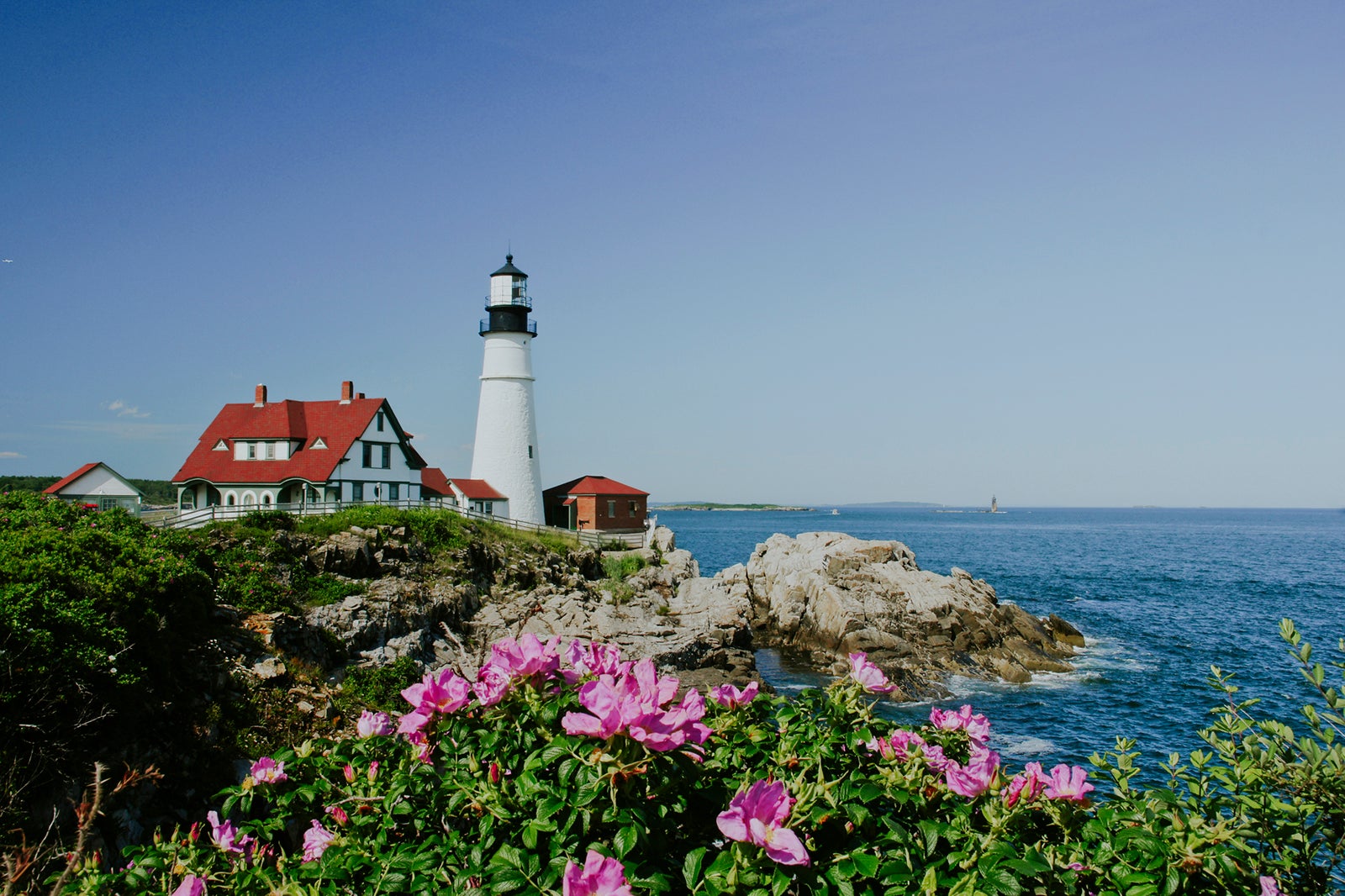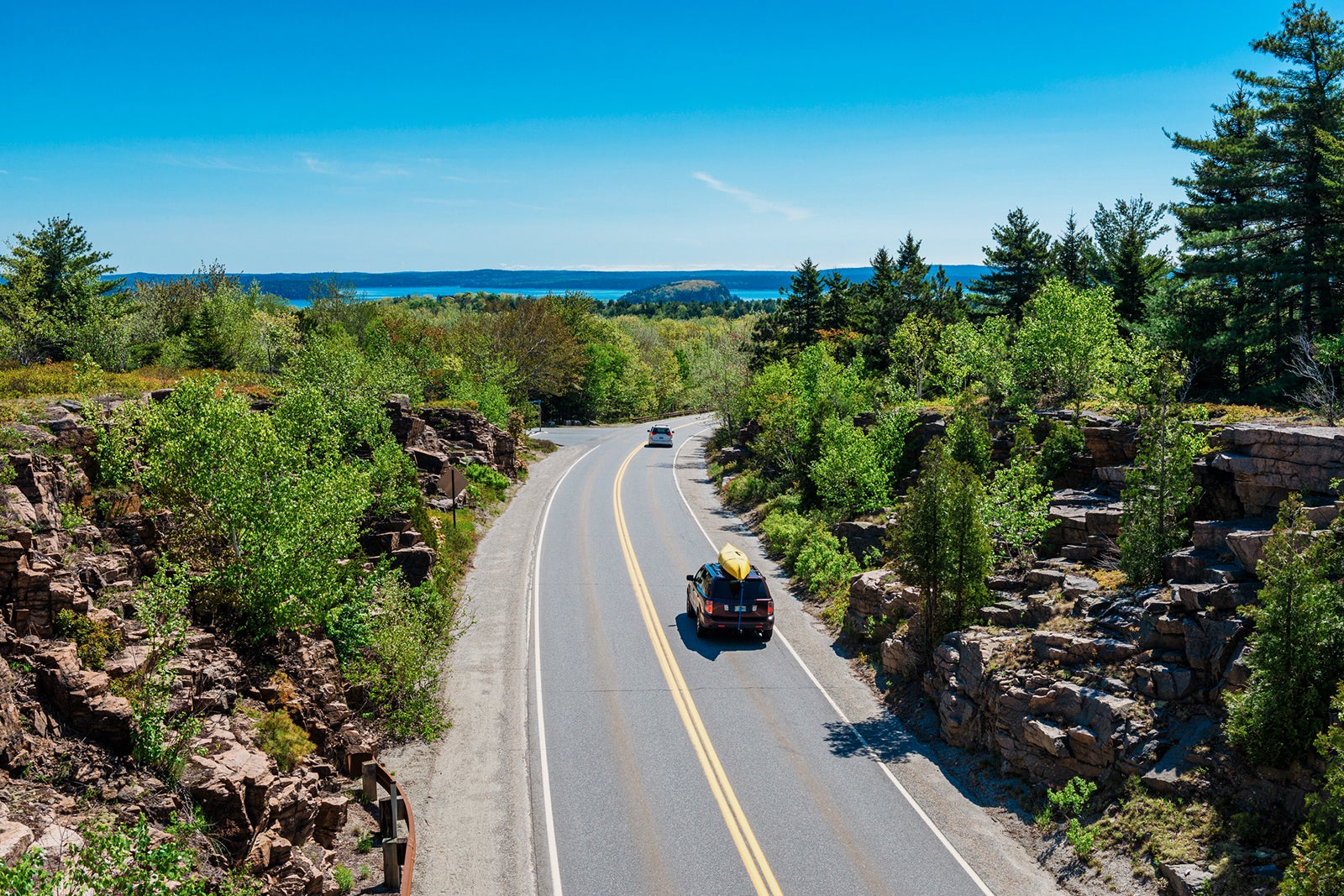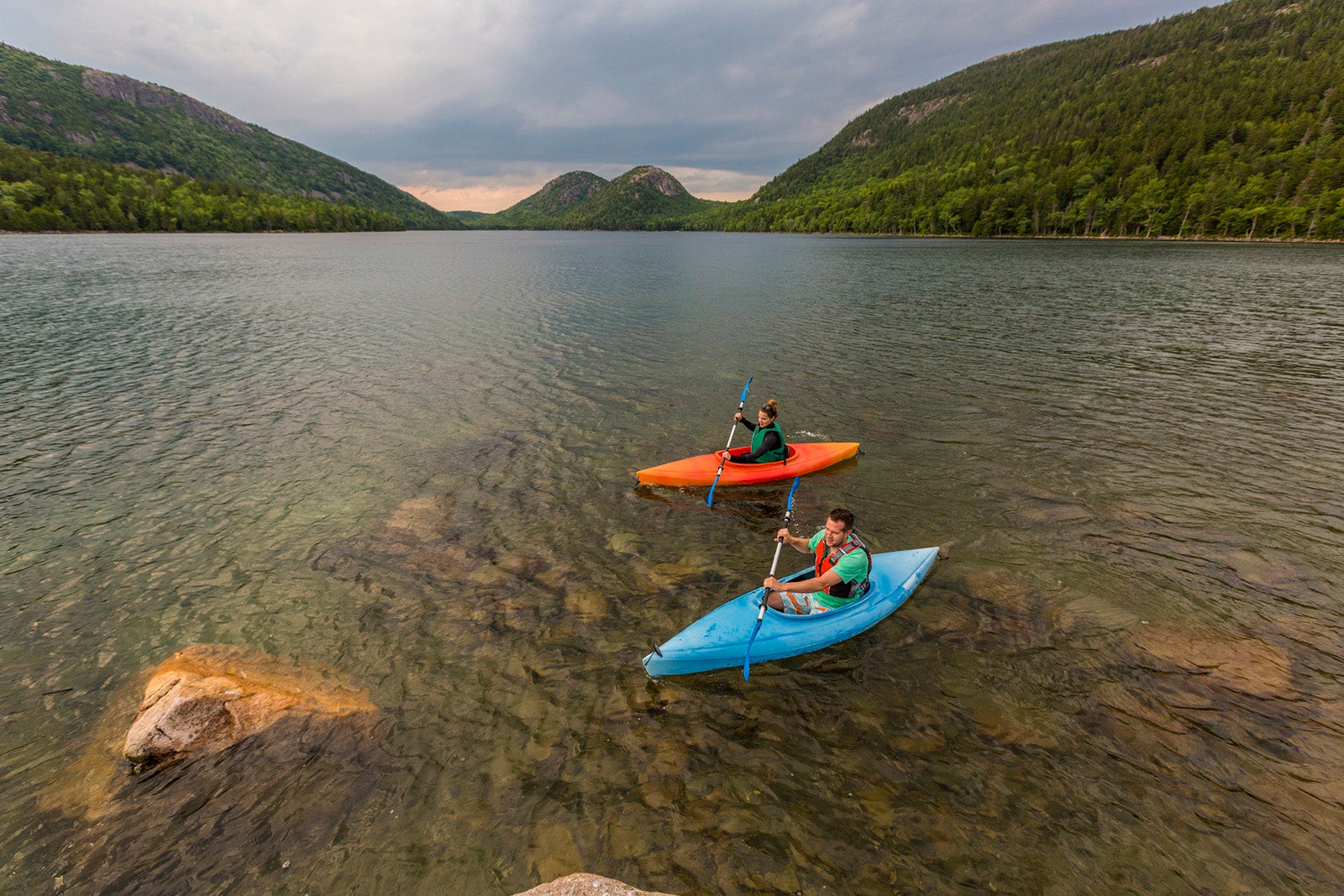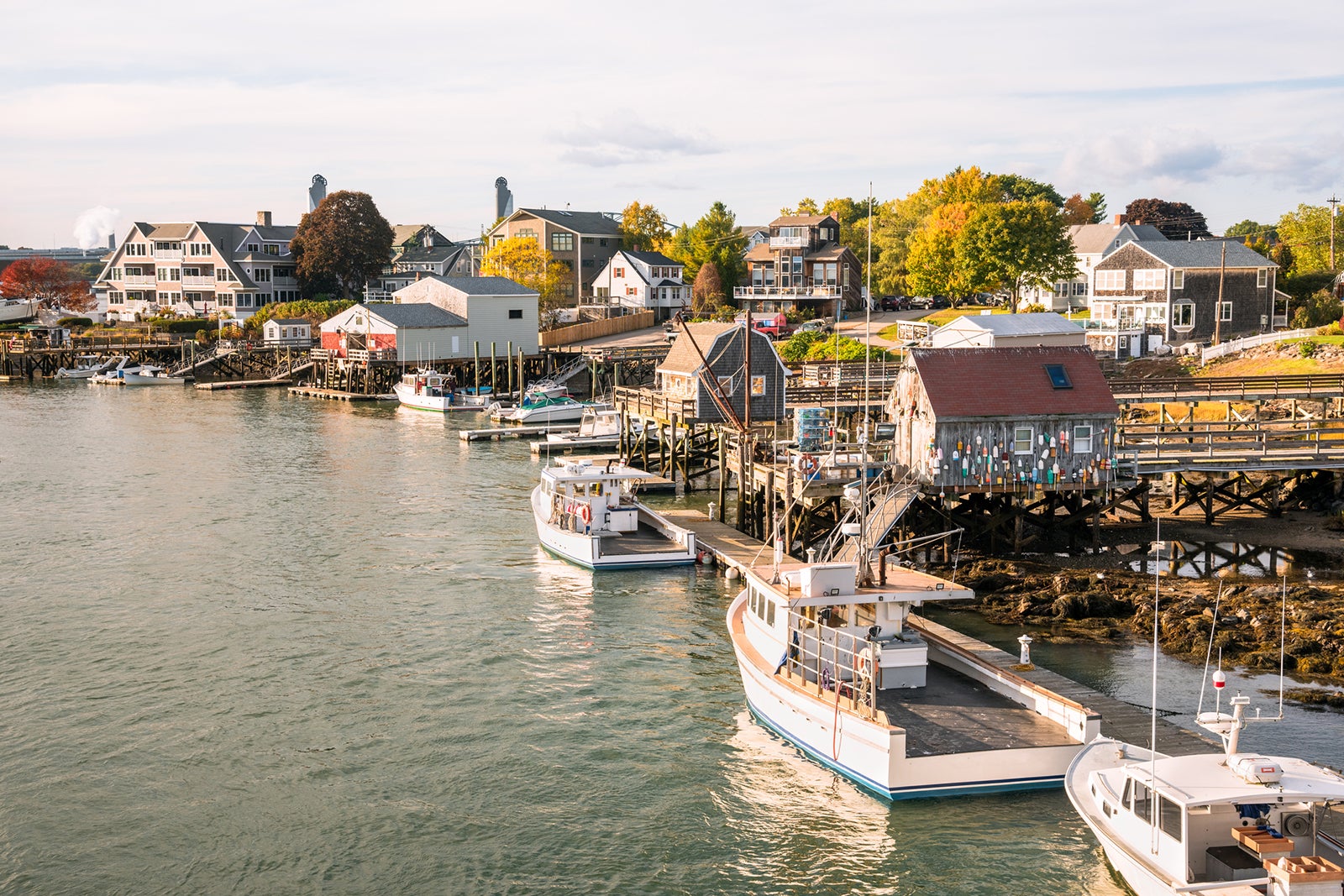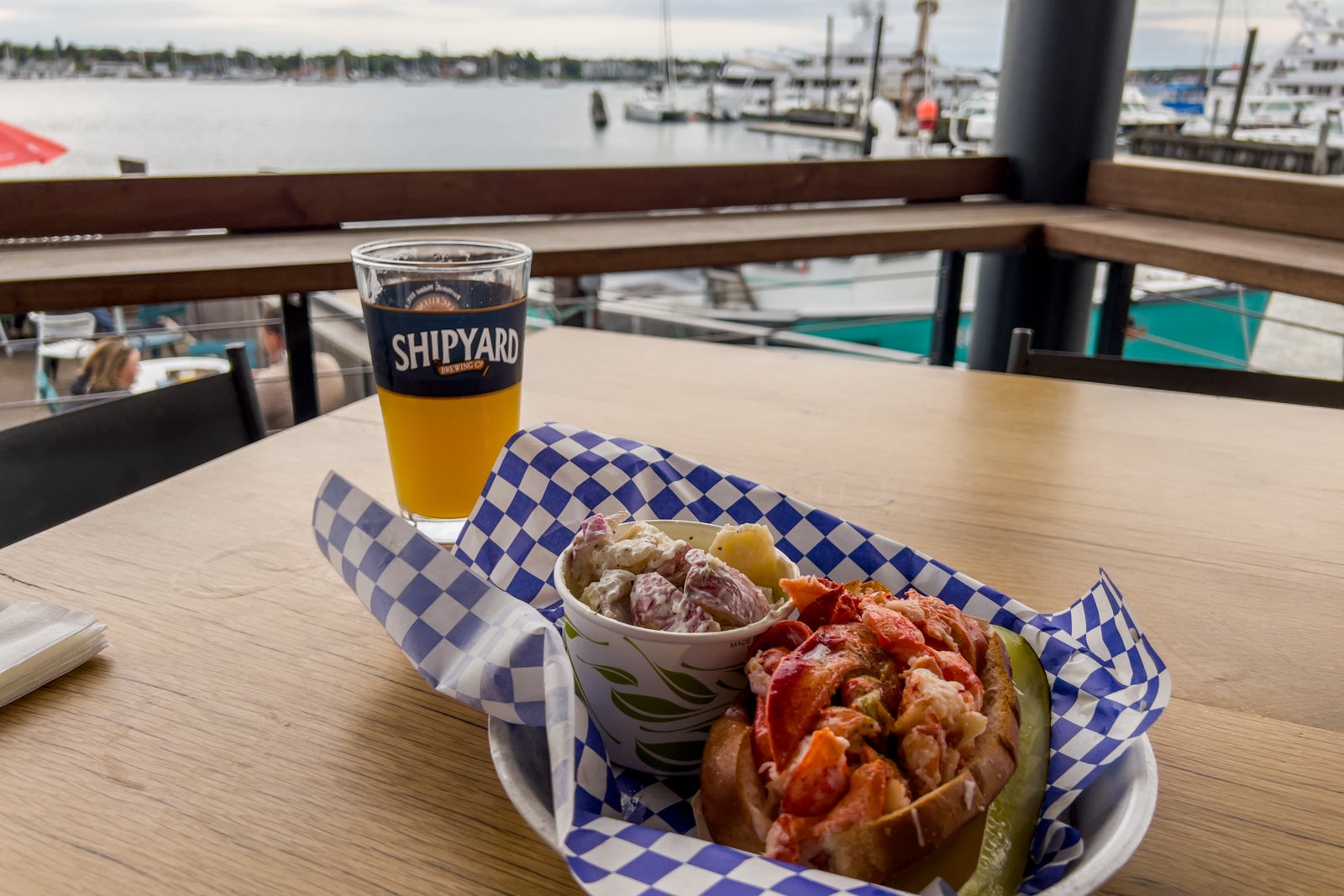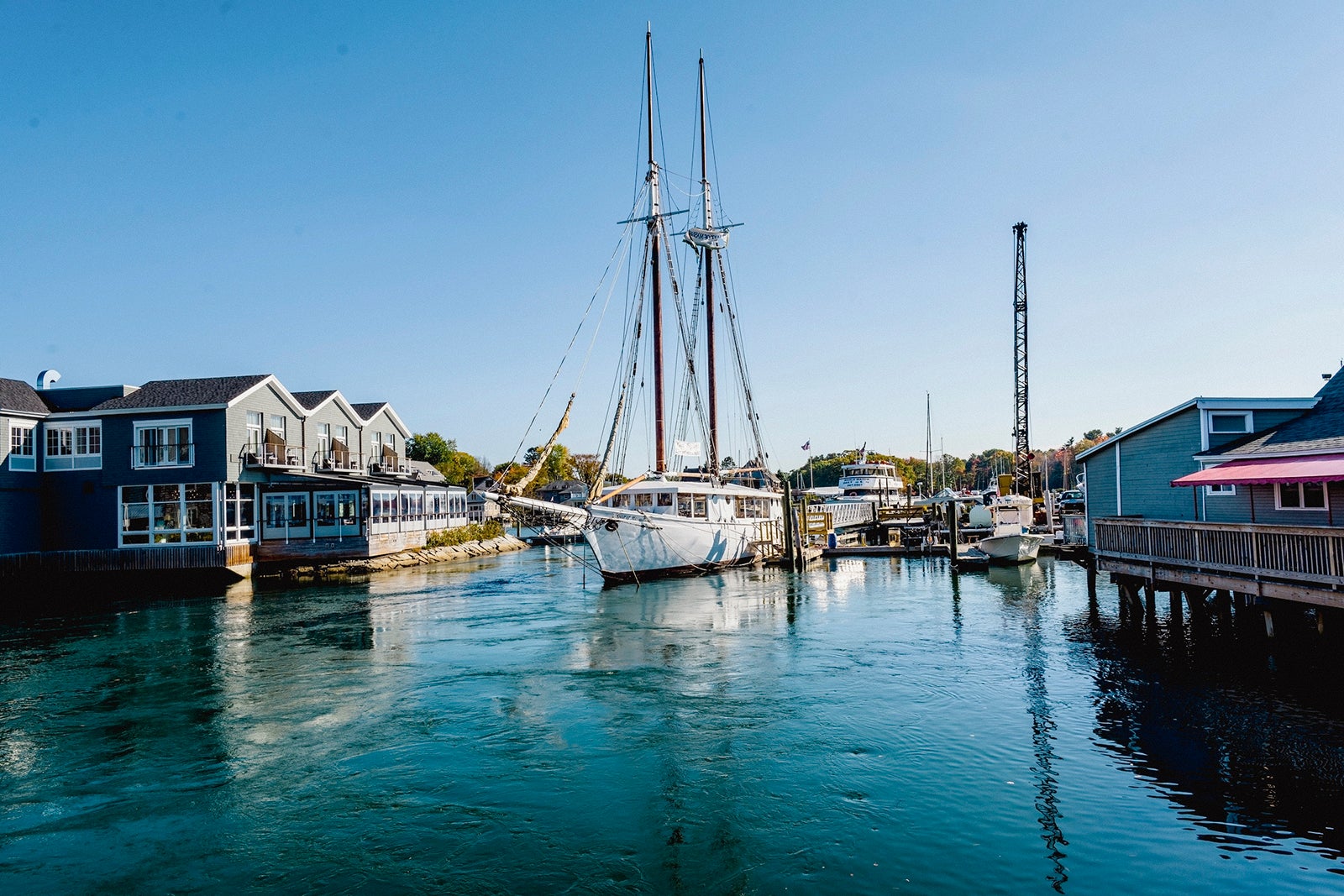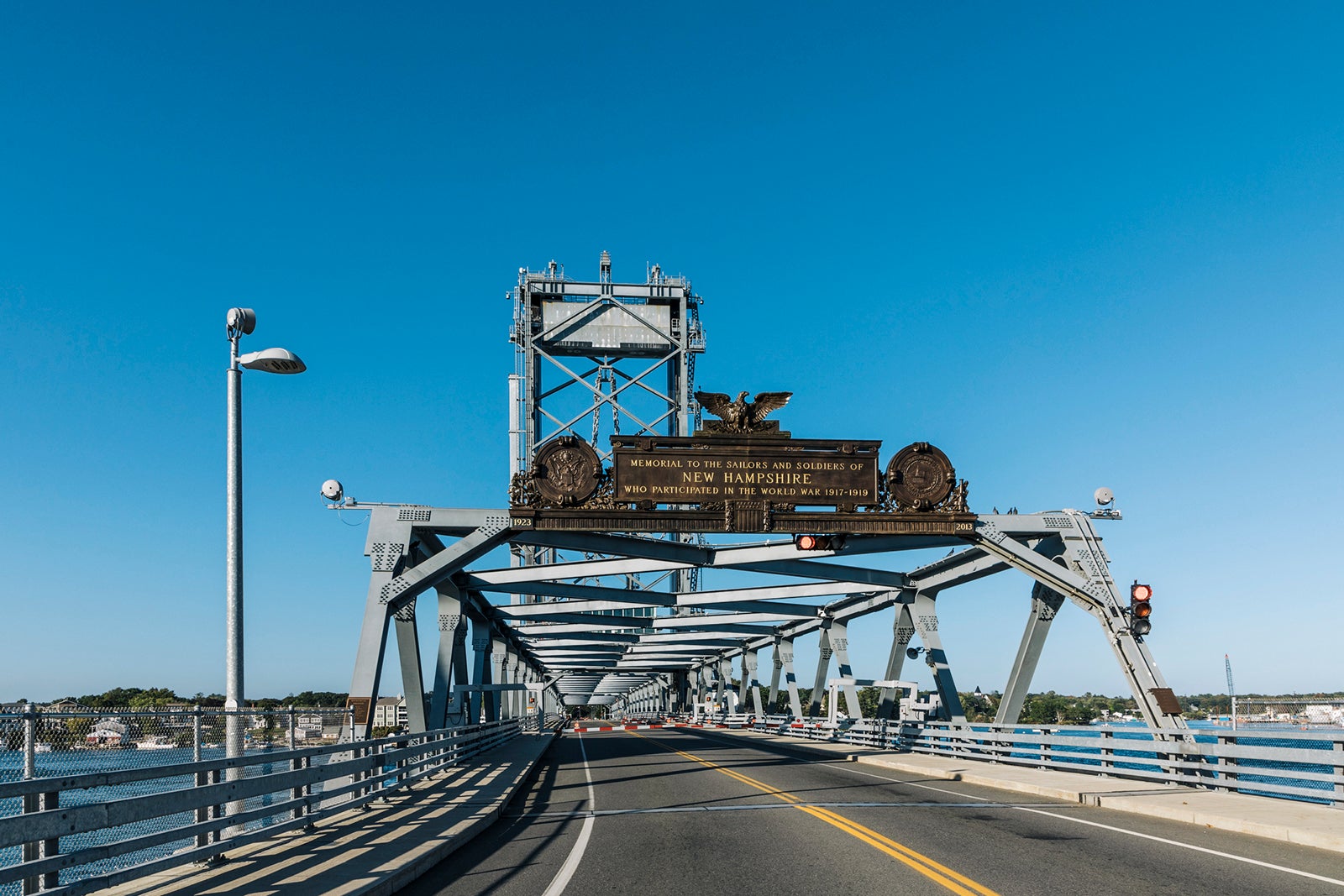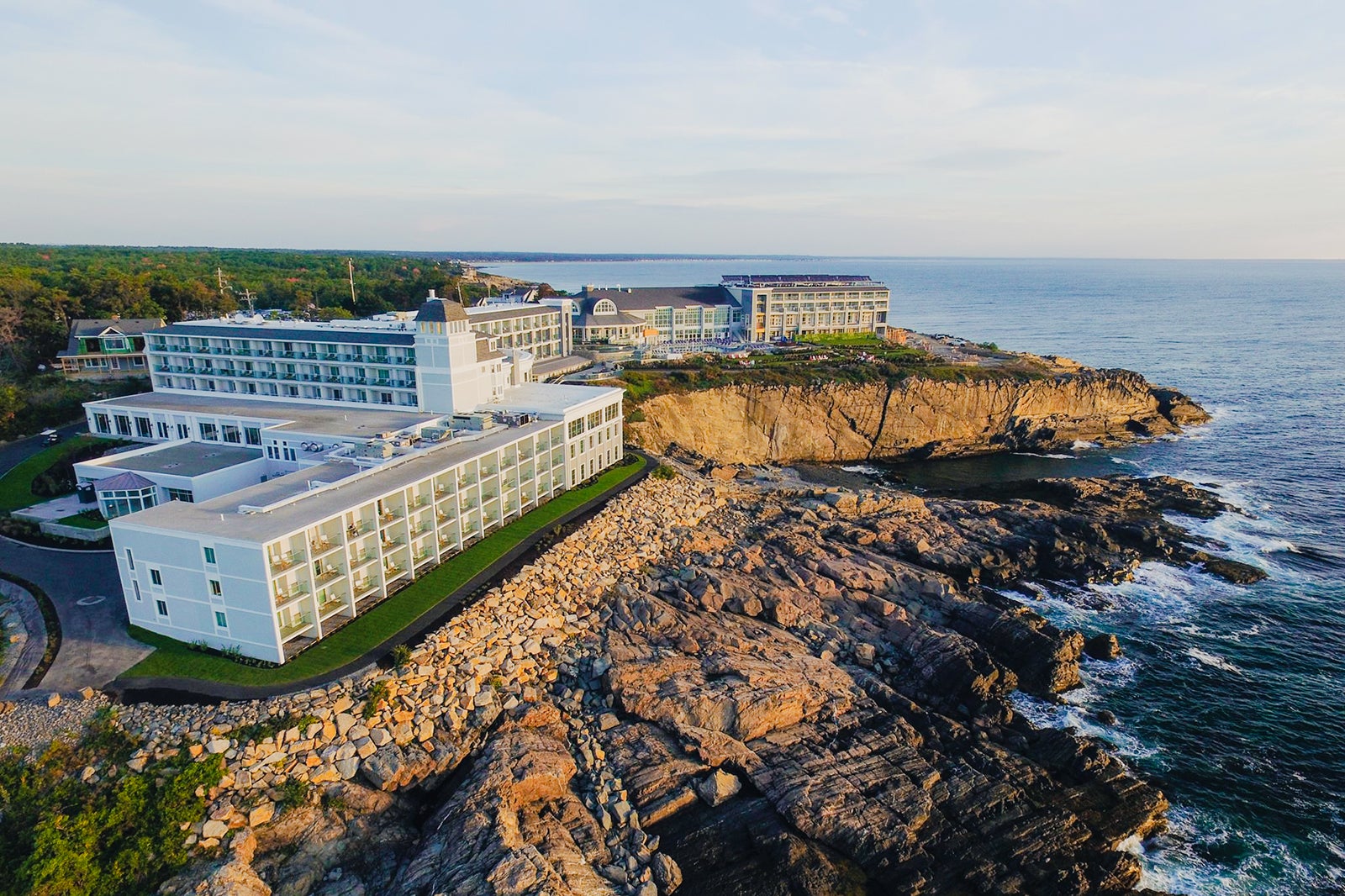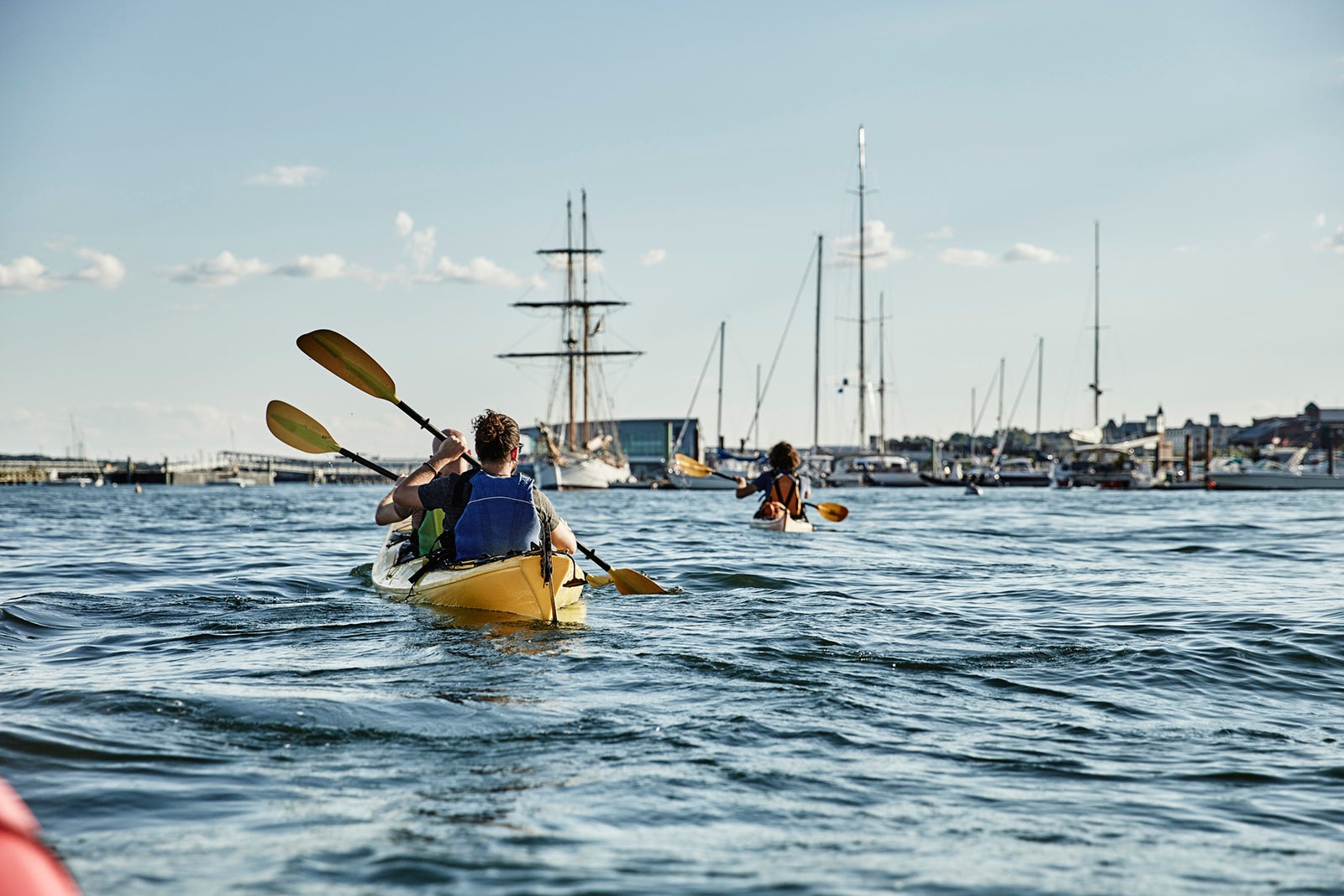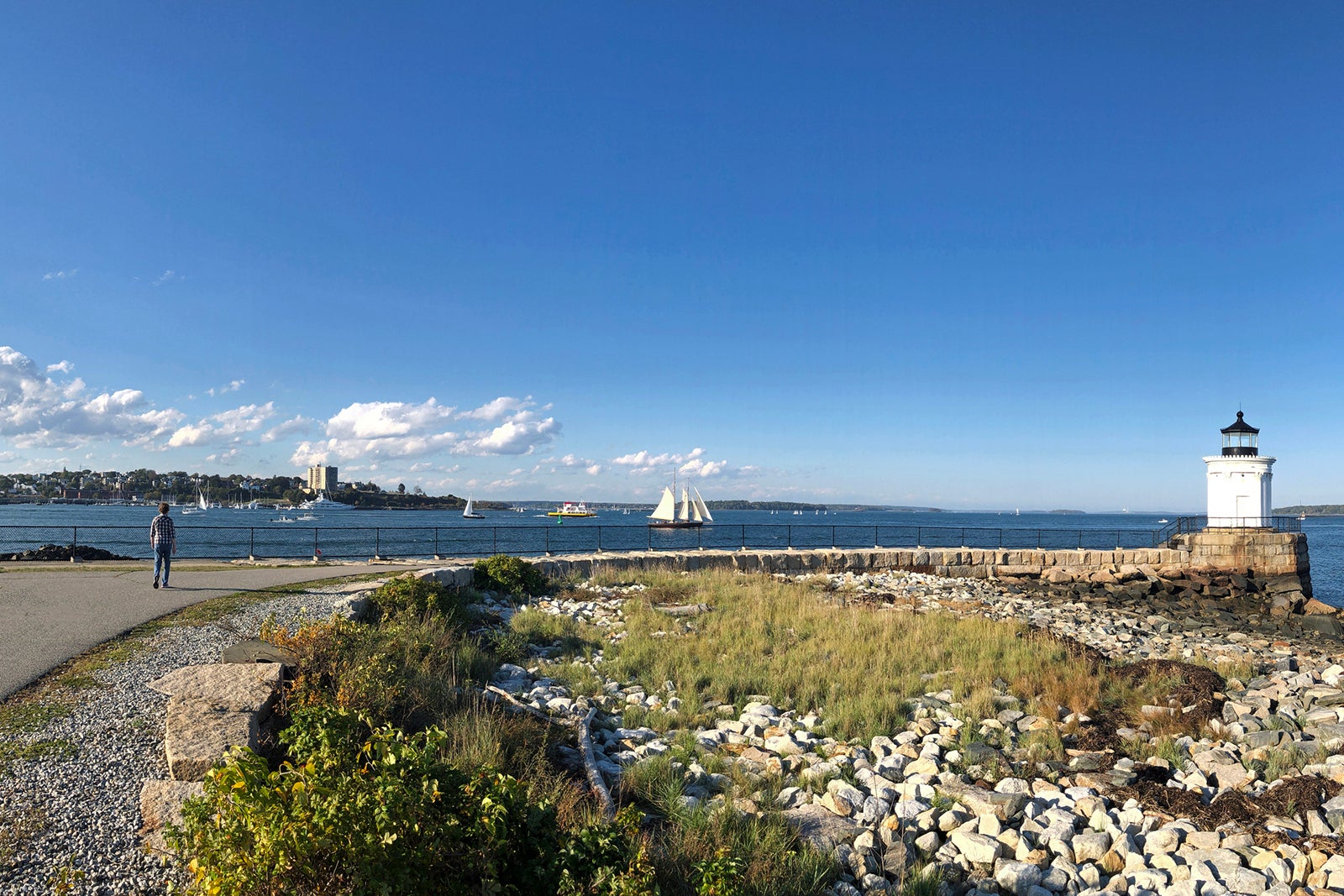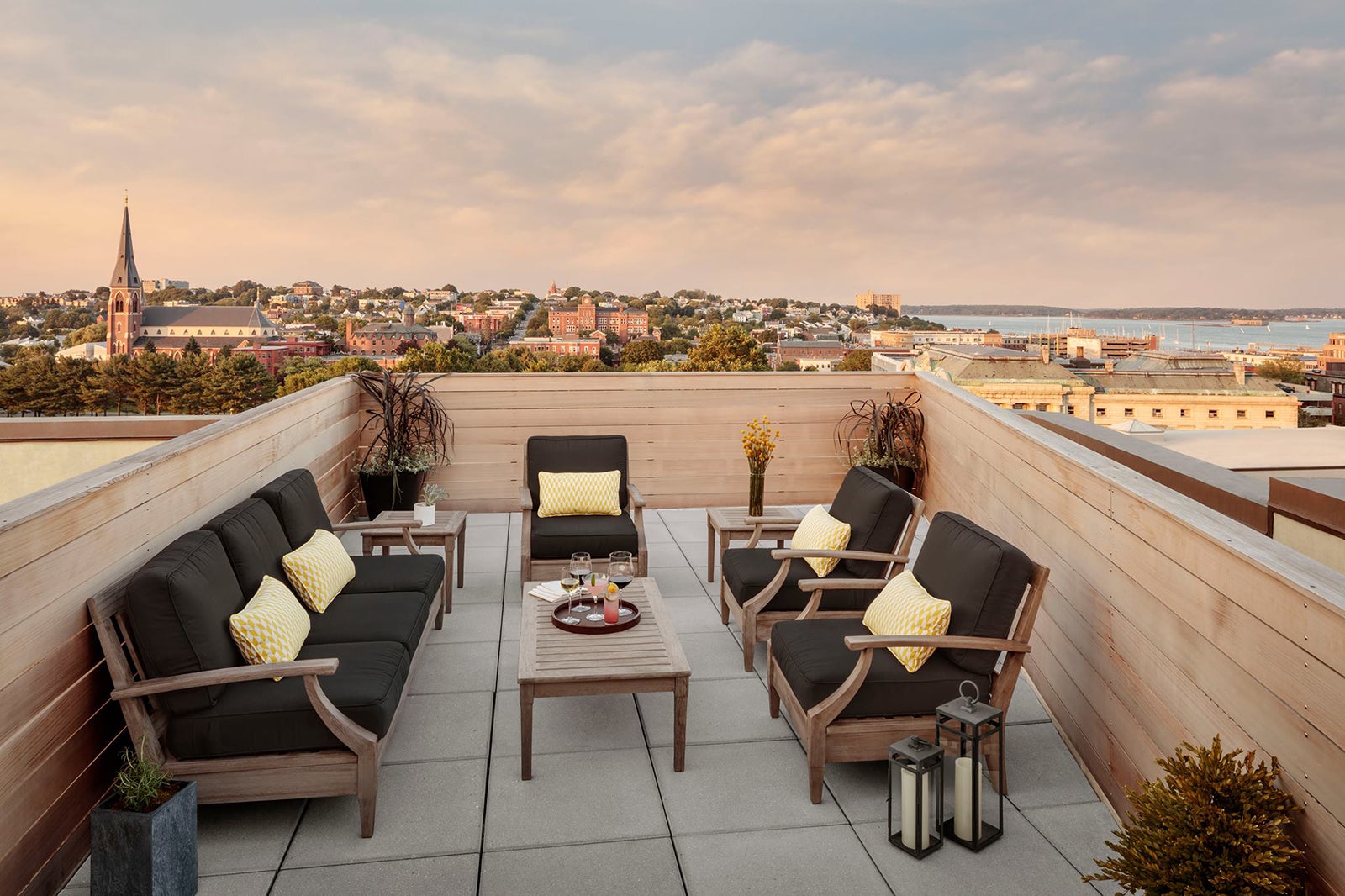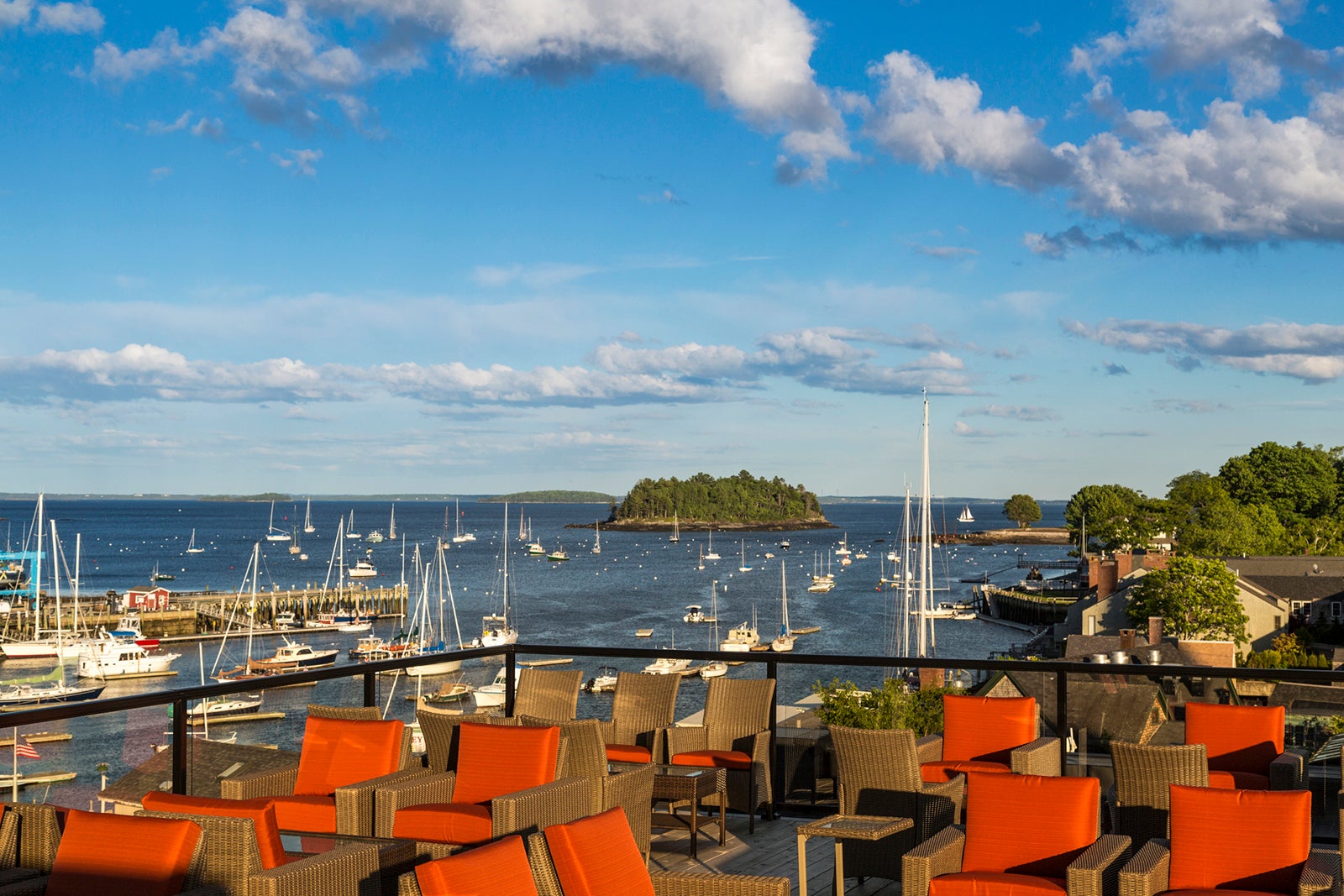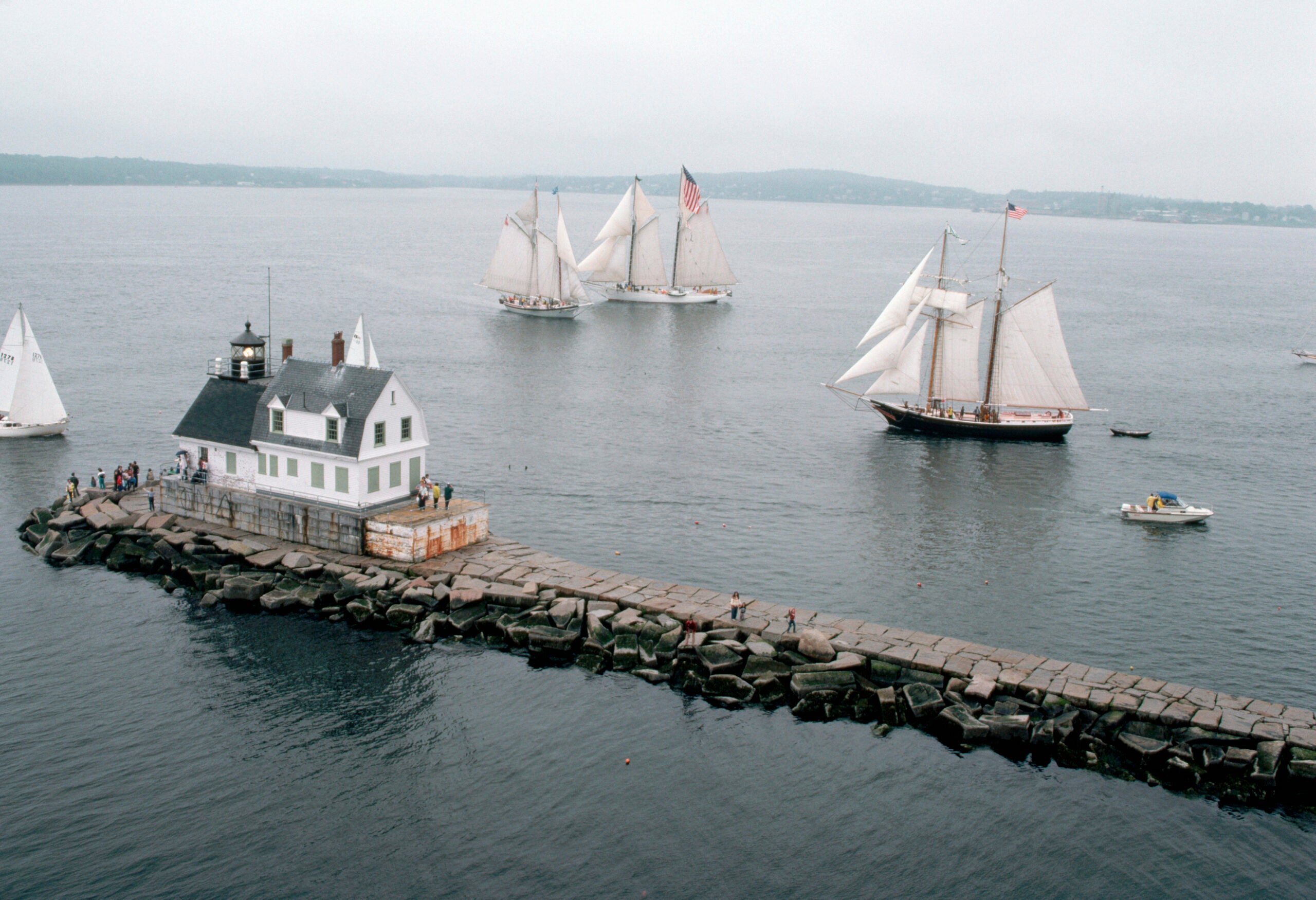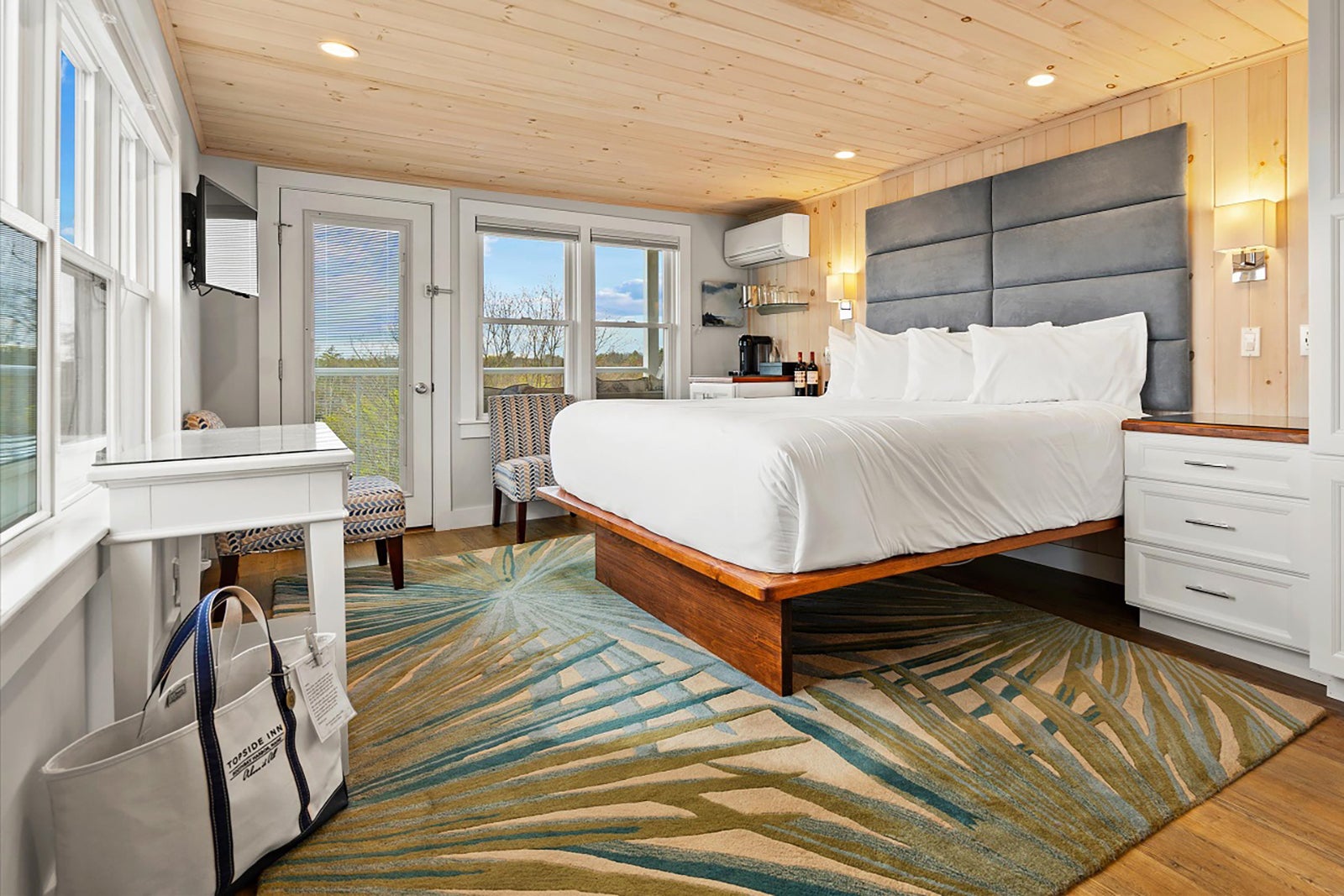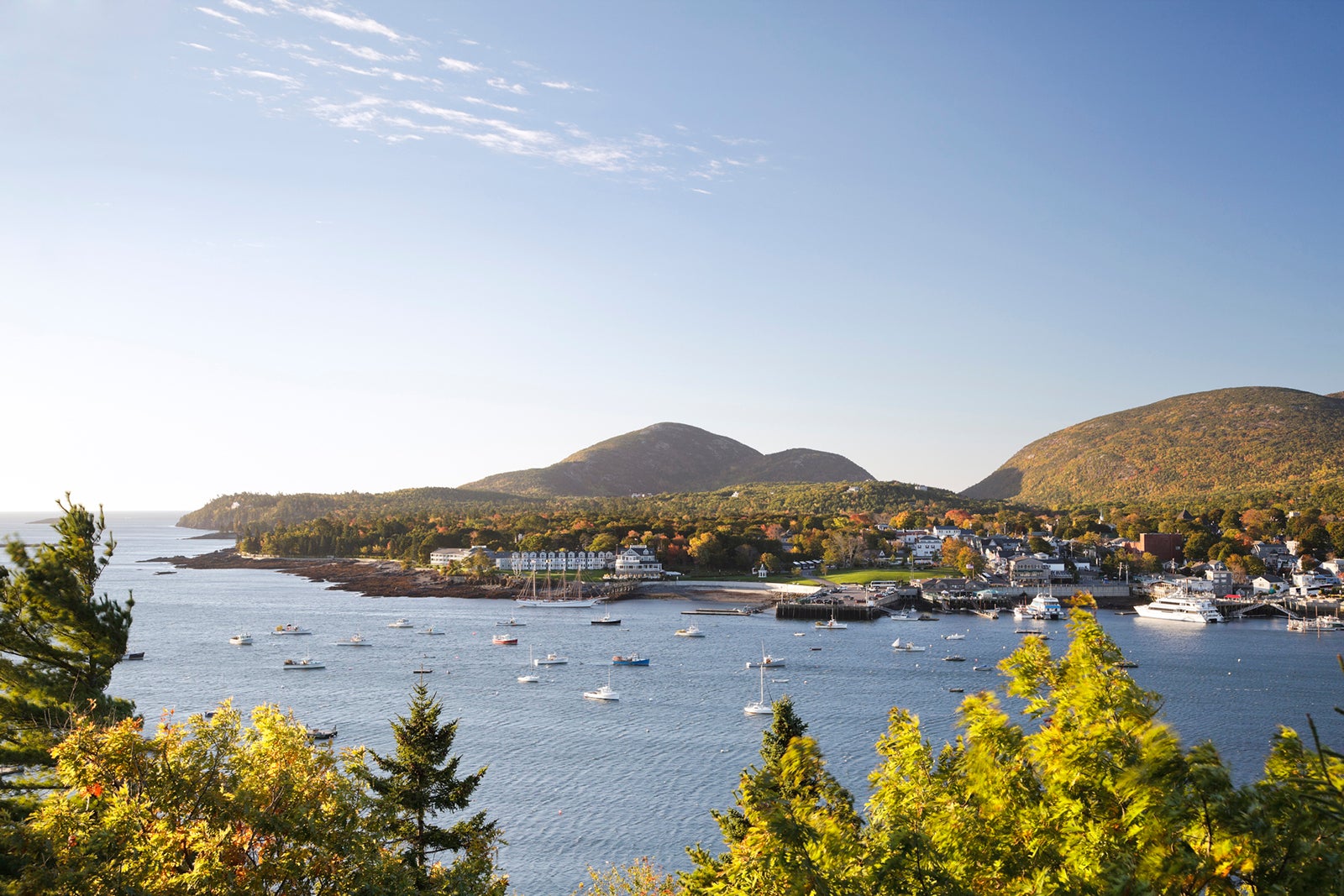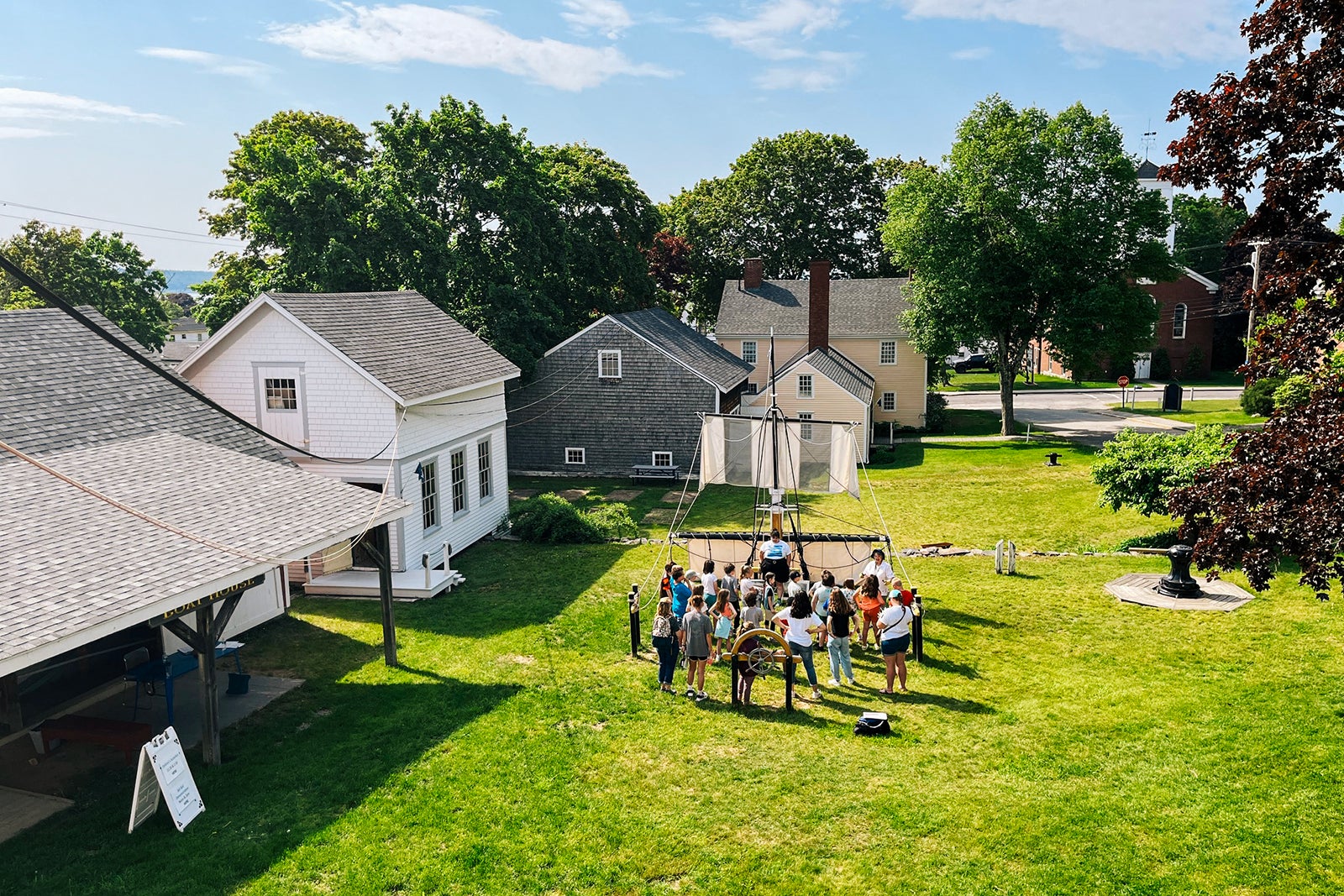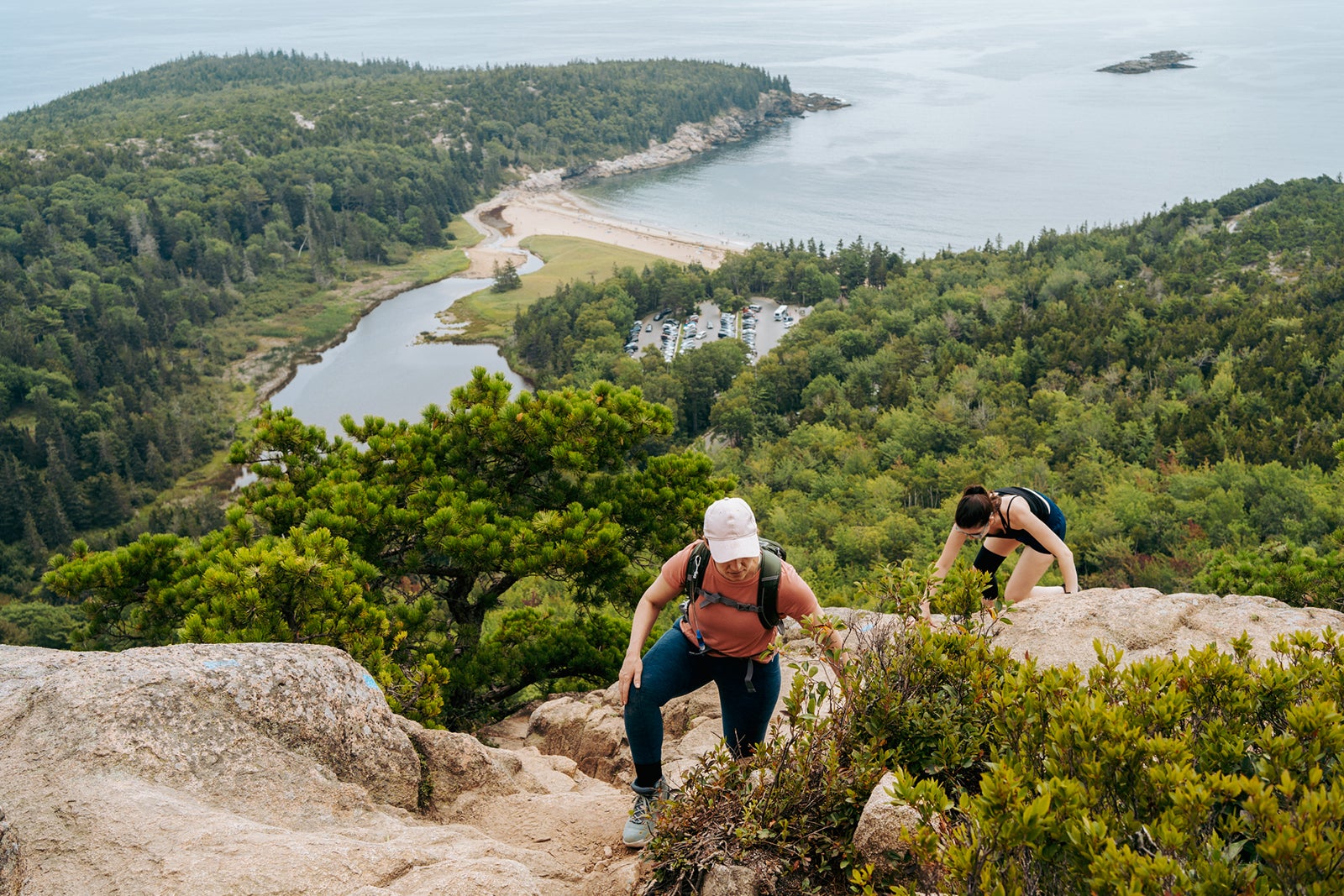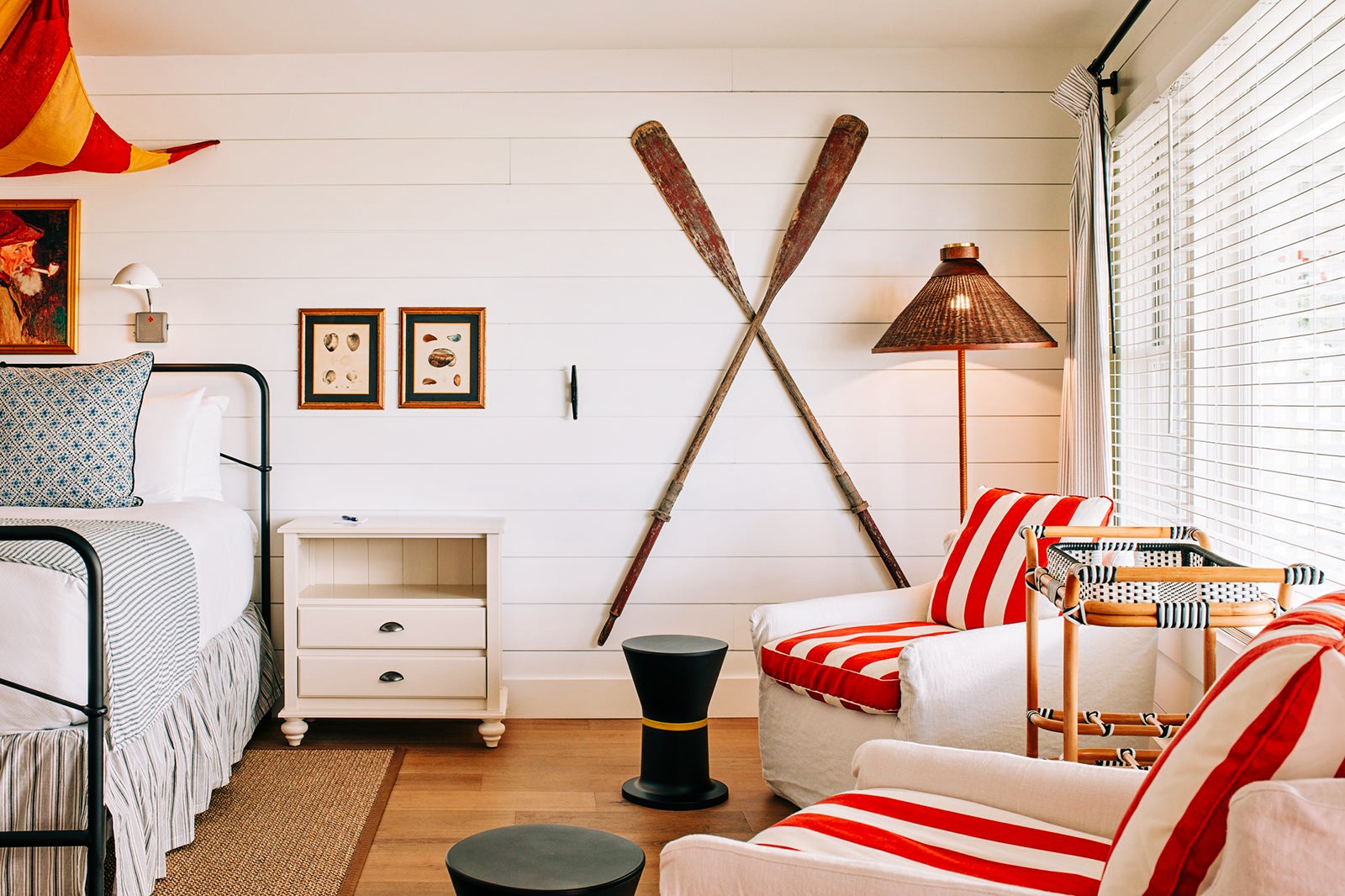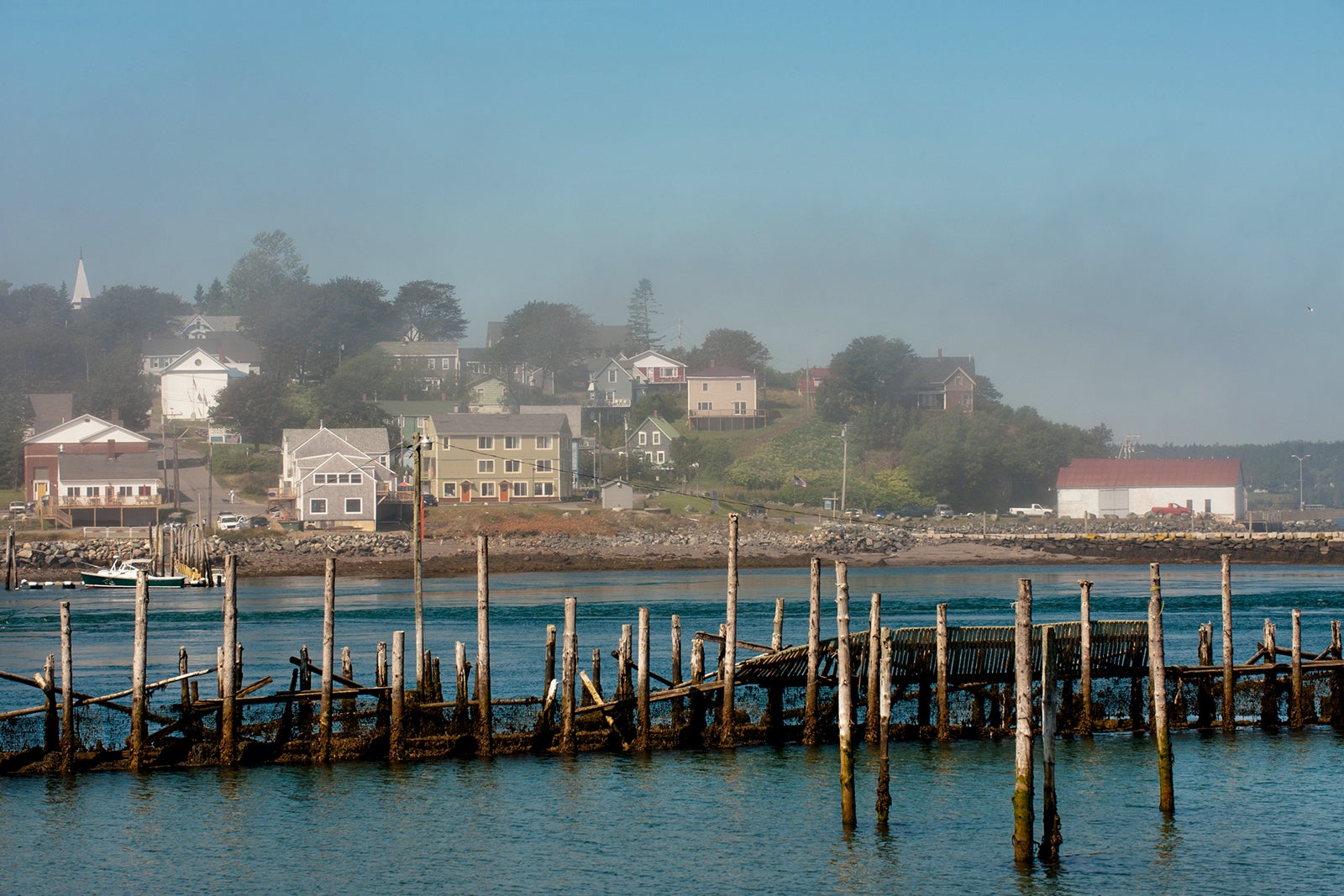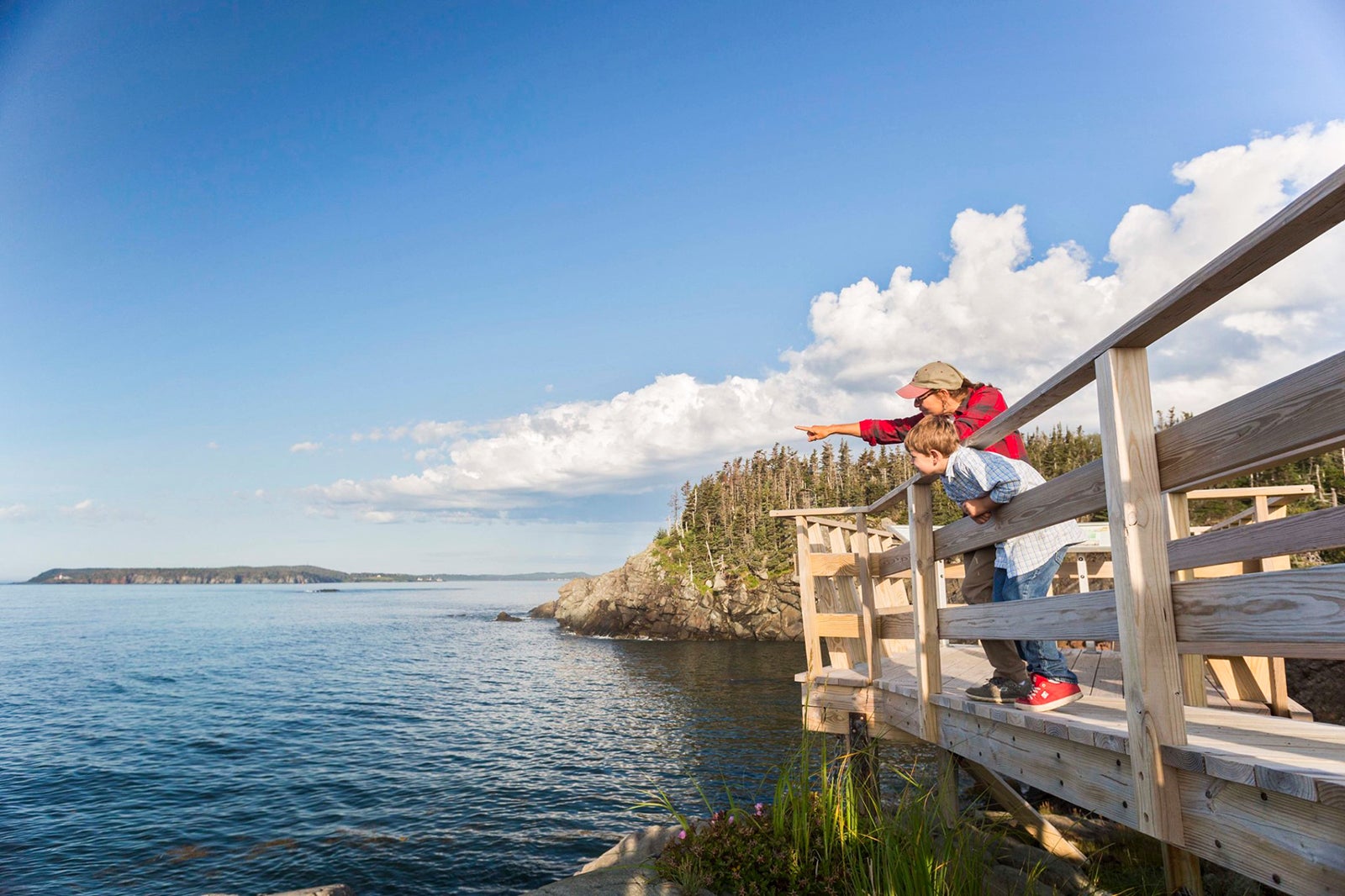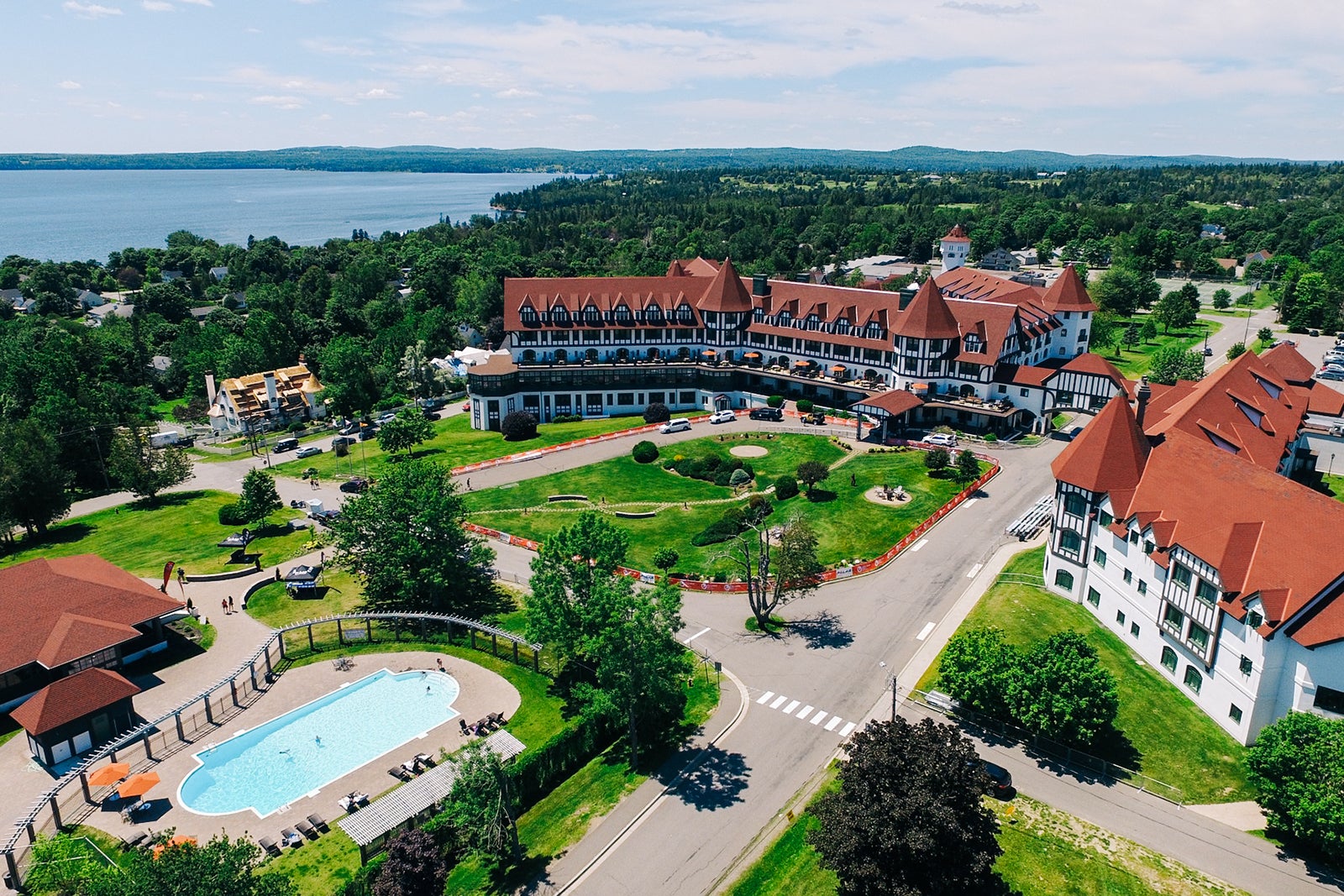Maine’s breathtaking coastline is unlike any other. It’s only about 280 miles from the New Hampshire border to the New Brunswick, Canada, border if you follow the region’s principal road, U.S. Route 1 (along with state Route 189 for the final stretch).
However, this jagged shoreline is anything but a straight shot. And if you measure the tide coastline — which includes every peninsula, inlet, island and tidal basin — the Maine coast actually measures 3,478 miles, making it the fourth-longest in the country (it slightly exceeds California’s).
You could drive it sticking closely to U.S. 1 in about seven or eight hours, but you wouldn’t actually see much of the ocean. For views of Maine’s azure waters — its rocky headlands dotted with imposing historic lighthouses, its sheltered harbors aglow with sleek sailboats and colorful lobster buoys — you’ll want to detour frequently from the main route. To fully experience this breathtaking maritime landscape immortalized in the paintings of Winslow Homer, Marsden Hartley, Andrew Wyeth and countless other luminaries, spend at least a few days (or ideally a couple of weeks) tracing the coast’s many contours.
As you traverse the coast in a northeasterly direction, heading “down east” as it’s known in Maine vernacular, you’ll encounter far fewer people and much less commercial development. The relatively direct stretch from the New Hampshire border to the state’s largest city, Portland, abounds with sophisticated sea-to-table restaurants and posh country inns as well as charming lobster shacks, enticing ice cream stands and nostalgic minigolf centers. Once you get past Freeport, with its iconic L.L. Bean flagship store, you start to encounter the wilder and more rugged Maine coast, with its long and narrow peninsulas.
Along this part of the coast, you’ll still find pockets of upscale vacationers in affluent summer colonies like Boothbay Harbor, Camden and Bar Harbor, but the pace slows. The final stretch of coast beyond Mount Desert Island to the Canadian border feels completely rural. You’ll encounter few fellow travelers in this sparsely populated but verdant area that depends economically more on commercial fishing and blueberry farming than tourism.
But by exploring the full length of Maine’s gorgeous coast, you’ll find much to appreciate. You can feast on incredible seafood (not just lobster but rock and Jonah crab, oysters, mussels, and myriad fish) and a dizzying variety of craft beers. You’ll discover superb art museums and galleries, and diverse flora and fauna to view on coastal hikes, wildlife-watching cruises and kayaking and biking tours. And, of course, there’s the stunning natural scenery of Acadia National Park.
Here’s your guide to planning the perfect coastal Maine road trip and everything you should see and do along the way.
Maine road trip planning
GPS devices tend to be at cross purposes with actually enjoying a drive up the Maine coast, as they constantly attempt to shunt you onto U.S. Route 1 or, worse, Interstate Highway 95, instead of the happily meandering and circuitous roads that run closer to the shoreline. Unless you’re pressed for time, feel free to ignore the entreaties of your GPS and take the scenic route whenever possible. Detour down to the tips of Maine’s finger-shaped peninsulas, and if there’s an island you can reach by bridge or even by ferry, go for it, at least once. Bailey Island, Deer Isle and Vinalhaven (which entails a ferry ride) are all good bets.
Note that many municipal beaches have steep parking fees for nonresidents, sometimes $25 or more. Day-use fees at state beaches are per person rather than per vehicle and typically cost around $7 or $8 per person. In Portland and some of the more popular small towns along the coast — Bar Harbor, Kennebunkport, Ogunquit — street parking can be hard to come by, especially during the summer high season, so prepare to use a pay lot that may also be expensive.

Daily Newsletter
Reward your inbox with the TPG Daily newsletter
Join over 700,000 readers for breaking news, in-depth guides and exclusive deals from TPG’s experts
Gas stations are present all along U.S. Route 1 and in most towns, but they can be harder to find, or a lot more expensive, on the more rural peninsulas and islands. It’s best to top off your tank before venturing anywhere remote.
Set aside enough time
If you’re driving this full itinerary from Kittery to the Canadian border, give yourself a minimum of five days and four nights to be able to experience the key sights along the way. This allows you to set aside a full day each for exploring Portland and Acadia National Park, and enough time to drive through all of the towns described in this article. To appreciate this trip at a more leisurely pace, budget a week to 10 days and try to spend two nights in some of the more prominent areas, such as Kittery-Portsmouth, Portland, Rockland-Camden, and Bar Harbor-Acadia National Park. If you have two weeks or even longer, you won’t run out of engaging things to see and do.
Getting to the Maine coast
Boston Logan International Airport (BOS) has by far the greatest number of direct flights in New England, and it’s just a 75-minute drive from the Maine border. Another option is to fly into Maine’s small, user-friendly Portland International Jetport (PWM), which is a 45-minute drive from Kittery. A lesser-known option that’s just a 50-minute drive from Kittery is Manchester-Boston Regional Airport (MHT) in New Hampshire. It’s served by several of the major airlines. Although Logan Airport is likely the easiest to reach from much of the country and many international destinations, it is a busy hub in a city with notorious traffic, and rental car rates tend to be steeper than at the airports in Portland and Manchester, which are also smaller and more pleasant to navigate.
From Boston, Amtrak serves Portland and several smaller towns along the lower Maine coast. And there’s frequent daily bus service on multiple carriers from Logan Airport and downtown Boston to both Portsmouth and Portland.
Best starting and end points on the Maine coast
This itinerary follows Maine’s coast in a northeasterly direction, beginning at the town of Kittery, which is just across the Piscataqua River from Portsmouth, New Hampshire. This corner of the state is easy to get to, as it’s just a 75-minute drive up the coast from Boston via I-95, and there are plenty of hotels in the area, both on the New Hampshire and Maine sides of the border. This trip ends at the Canadian border, where you have the option of extending your adventure by continuing into New Brunswick and potentially beyond. Although it can take several days to travel along the coast’s meandering roads, exploring its peninsulas and inlets, the drive back from Lubec to Kittery-Portsmouth takes just under five hours if you take the most direct interior route (state Route 189, U.S. Route 1, state Route 192 and state Route 9 to Bangor, and then I-95 the rest of the way).
The best time to visit the Maine coast
For the best balance of weather and scenery without excessive crowds or super-steep hotel rates, make this trip during the spring and fall shoulder seasons, between May and mid-June or mid-September and mid-November. The exception to this rule is fall’s peak foliage season, which along the Maine coast is generally from around mid-September through the first week of November. Although the coast attracts fewer leaf-peepers than interior New England, crowds do pick up around this time and hotel rates can also spike a bit.
July and August are peak high-season, as are holiday weekends in spring and fall. This is the best time to laze on Maine’s beaches and even swim in the ocean (which is still pretty chilly, with highs averaging around 70 degrees in summer). It’s also when seasonal businesses like lobster shacks, ice cream stands and scenic tour boats have their longest hours. But you’ll pay a premium at coastal hotels during this time (note that the starting rates for hotels recommended in this article are for the summer high season).
Conversely, winter on the Maine coast can be a bargain as long as you don’t mind bundling up, and you’ll sometimes have beaches all to yourself. But many businesses, including lodgings and restaurants, shut down in winter — and in some cases all the way from mid-October through early May, especially the farther up the coast you go.
Kittery to the Kennebunks
More than any other section of Maine’s coast, this relatively short (30-mile) stretch in the state’s southwestern corner is easiest to access from coastal roads, which more or less parallel the shore’s contours, even beyond Kennebunkport and up through Cape Elizabeth and South Portland.
The region is characterized by broad, crescent-shaped, golden beaches and is home to the greatest concentration of tourism-related businesses. You’ll find no shortage of accommodations, from swanky seaside inns to low-frills, family-friendly motels to vacation rentals of every configuration and price range. Although the population swells in summer and traffic can slow to a crawl on weekends, don’t give in to the temptation to skip this region in favor of the quieter areas beyond Portland. It’s a beautiful part of the state with a number of appealing attractions. What you might consider doing, however, is timing your trip so that you’re in this area midweek rather than during the busier weekend.
Kittery and the Yorks
Start your journey by taking U.S. Route 1 over the Memorial Bridge, which crosses the Piscataqua River from historic downtown Portsmouth, New Hampshire, to Kittery, Maine’s oldest town. If you want to fuel up early, stop on Badger’s Island, which is right in the middle of the river, for a hearty meal at Ore Nell’s Barbecue or in the historic downtown at Lil’s Cafe, an artisan bakery with great coffee drinks.
Continue east on state Route 103 along the curving riverfront rather than following U.S. Route 1 into the tangle of outlet shops for which Kittery is most famous. Stop to walk around colonial-era Fort McClary State Historic Site, with its formidable granite walls and views of pretty Portsmouth Harbor. The road curves past characteristic colonial homes before joining with U.S. Route 1A, a scenic coastal road that passes through the classic seaside vacation villages of York Harbor, York Beach and Cape Neddick. These towns have a nostalgic family vacation vibe and there are plenty of places to hop out for a stroll along the sand or a bite to eat overlooking the sea.
Just north of York Beach — a stretch of beach cottages and hotels that looks like a postcard from the 1940s — turn right (follow the signs) to the parking area for what’s quite possibly the most photographed building in Maine: Nubble Lighthouse, an elegantly simple white tower beside a red-roofed Victorian keeper’s house set on a small rocky island just offshore. You can’t actually visit the island, but the view from across the water is splendid, and next to the parking lot, Fox’s Lobster House is a good spot to indulge in your first bowl of chowder or lobster roll.
Optional side trip to Portsmouth, New Hampshire
The largest community on New Hampshire’s 18-mile shoreline, this upbeat historic city with a population of around 23,000 is both an excellent base for exploring the adjacent southwestern corner of Maine and a delightful destination in its own right.
A compact seaport, Portsmouth is known for its carefully preserved colonial buildings, many of them open to the public. A highlight is Strawbery Banke Museum, a 10-acre living history village of more than three dozen restored structures. Sometimes described as a miniature Portland, this city of narrow tree-shaded lanes and well-tended gardens has a growing restaurant scene and plenty of galleries, crafts shops, bookstores and clothiers to keep you busy.
Ogunquit
Just north of Cape Neddick, where U.S. Route 1A cuts west to join U.S. Route 1, turn right onto Shore Road and follow this narrow, curvy route into charming Ogunquit, which developed into an artists colony and a summer resort in the late 19th century and has in more recent decades become a popular LGBTQIA+ destination. Testament to this cheerful beach town’s creative legacy are the small but excellent Ogunquit Museum of American Art and the acclaimed Ogunquit Playhouse summer theater. Be sure to check out the shops and seafood eateries (such as Footbridge Lobster and Barnacle Billy’s) of Perkins Cove, where there’s also a photogenic footbridge across the town’s boat basin. From here, walk the stunning 1.3-mile Marginal Way footpath along a series of sea cliffs into the cute downtown, where you’ll discover a number of hip bars and restaurants.
Kennebunkport
As you head north on U.S. Route 1 from Ogunquit, turn right onto the state Route 9 shore route into the old-money enclave of Kennebunkport, with its appealing village center bisected by the scenic Kennebunk River. Stroll among Dock Square’s many shops and restaurants, where you can also book a sightseeing cruise on The Pineapple Ketch, a historic 38-foot ship that provides a glimpse of the many imposing summer cottages (mansions, really) that dot the town’s shoreline, including Walker’s Point, aka the Bush compound, which served as the “Summer White House” for President George H.W. Bush. Off Dyke Road a few miles northeast of town, Goose Rocks Beach is one of the area’s gems, offering great opportunities for tidepooling and soaking up rays.
Where to stay
With days of driving ahead, you might consider treating yourself to a night or two in a fabulous spa resort, like Cape Neddick’s sumptuous Cliff House Maine (rates start at $699 per night), which is perched on a dramatic rocky ledge a few miles south of the Ogunquit border. In addition to having a 9,000-square-foot spa overlooking the sea, this contemporary 226-room hotel boasts a championship golf course, several restaurants and myriad recreational activities. From the enchanting Trellis House (rates start at $309 per night), an eight-room bed-and-breakfast surrounded by lush gardens and greenery, you’re steps from Ogunquit’s Marginal Way coastal path and within walking or trolleying distance of the beach and local dining.
The contemporary-chic AWOL Kennebunkport (rates start at $327 per night) offers a distinct contrast to the area’s many old-fashioned inns. A short walk from lively Dock Square in Kennebunkport, it’s made up of 17 airy cabins with low-slung, tasteful furnishings and private patios and balconies. Most rooms have fireplaces, and rates include a breakfast featuring a toast bar with bagels, muffins, breads and gourmet toppings. AWOL is part of the renowned boutique hotel brand Lark Hotels, which has four other Maine properties, including the stunning Kennebunkport Captains Collection (rates start at $471 per night), which is just around the corner and consists of four smartly updated historic homes with plush rooms and suites outfitted with soaking tubs, working fireplaces and plenty of other perks.
Just across the state line in Portsmouth, you’ll find a great selection of both modern full-service hotels and distinctive urban inns. A couple of notables include the Hotel Thaxter (rates start at $369), a new 15-room boutique inn within the heart of the city’s historic downtown, and Wentworth by the Sea (rates start at $389 per night), which is a 10-minute drive outside of town on the beautiful New Castle island. This legendary grande dame was built in 1874 and overlooks a scenic harbor where the Piscataqua River meets the ocean. It offers a spa, two pools, tennis courts and a Scottish-style links golf course.
Greater Portland
Maine’s largest city has just under 70,000 residents and is 50 miles up the coast from the New Hampshire border. In addition to being a picturesque port city with an incredible food scene, it’s an excellent place to anchor yourself if you’re planning a longer stay and appreciate having proximity to both the sea and a vibrant arts and cultural scene. From Kennebunkport, state Route 9 leads into the towns that form the metro area’s southern edge, including Biddeford and South Portland.
Biddeford and Cape Elizabeth
From Kennebunkport, follow Route 9 as it curves back inland along the Saco River into Biddeford, a once-thriving textile mill town that underwent a severe downturn during the second half of the 20th century as industry moved elsewhere. By the early 2000s, the city center’s handsome, though largely empty, redbrick mill buildings and storefronts began to attract chefs, brewers, makers, artists and other entrepreneurs, and today Biddeford buzzes with activity.
Stop for breakfast or lunch at acclaimed spots like Catface Cafe and the Palace Diner, or a memorable dinner at Elda. Sample fine spirits, including aromatic small-batch gins, at cozy Round Turn Distilling, and house-roasted coffees and local beer at the inviting bookstore-cum-cafe Elements.
Once you’ve filled up on excellent food and drink, follow U.S. Route 1 over the river into another small industrial city, Saco. Here, you have a decision to make about which route to follow. If you have a soft spot for the thrum of boardwalk amusement parks, fried-dough and saltwater taffy vendors, T-shirt shops and souvenir stands, and other retro-kitschy fun, head east a few miles to Old Orchard Beach, a spirited if at times raucous honky-tonk vacation town with a long pier, a beach that’s jammed on weekends with towels and umbrellas, and fireworks shows on Thursday nights from late July through early September.
If this isn’t your bag, continue up U.S. Route 1 to the bedroom community of Scarborough, and take state routes 207 and 77 through the upscale seaside town of Cape Elizabeth. On this scenic route, you can detour south to Prouts Neck to visit the Winslow Homer Studio (tours are offered only by advance reservation through the Portland Museum of Art), where the artist painted many of his legendary Maine seascapes from the 1880s until his death in 1910. And you can visit the Portland Head Light, which has served as a beacon to ship captains since 1791 and inspired countless paintings, including Edward Hopper’s memorable 1927 work, “Portland Head.” You can walk around this graceful stone tower and tour the museum inside the quaint keeper’s house — walking paths lead along the rock bluffs and throughout surrounding Fort Williams Park. Route 77 continues north across Casco Bay Bridge and into the heart of Portland.
Portland
With its walkable streets lined with stellar restaurants, cocktail lounges, fine galleries and fashionable boutiques, Portland is the perfect city to ditch your car for an afternoon, or even a few days, and explore on foot. The exercise will come in handy given how much eating and drinking you’ll be tempted to indulge in. Moreover, there’s a clutch of first-rate hotels downtown.
Great views can be had from the grassy lawns of the Western Promenade and Eastern Promenade, two hilltop parks that bracket the city. The Portland Museum of Art features extensive holdings of painters who have immortalized the region’s natural scenery, including Homer and Hopper but also John Marin, George Bellows and Andrew Wyeth. There’s also an outstanding contemporary collection and terrific rotating exhibits. A few blocks away you can visit the childhood home of poet Henry Wadsworth Longfellow, which now contains the Maine Historical Society. Nearby, the Old Port district exudes old-world charm with its bustling wharves, seafood markets and narrow lanes.
Where to eat and imbibe? Longtime favorites include Fore Street for locally sourced seafood and meats and Duckfat for Belgian-style frites and luscious milkshakes. Along the same block, head to Eventide Oyster Co. for fresh-shucked bivalves and its sister establishment, The Honey Paw, for boldly flavored pan-Asian cooking. Newer chef-driven spots such as locavore-minded Twelve and warmly convivial Thistle & Grouse are turning heads with their inventive, artfully prepared cuisine. And James Beard Award-nominated chefs are well represented in town; consider Krista Cole of Sur Lie (she also runs Gather, just up the road in Yarmouth), Courtney Loreg of Woodford Food & Beverage, Isaul Perez of Isa Bistro and Jake Stevens of Leeward, to name just a few. Allagash, Bissell Brothers and Austin Street are among the more than two dozen craft breweries making waves in and around Portland, while purveyors of everything from artisan baked goods (the Holy Donut, Forage, Norimoto) to locally roasted coffee (Tandem, Bard, Speckled Ax) appear in seemingly every direction. Prepare to be blown away.
The islands of Casco Bay
If you have an extra day, consider taking a cruise among the nearly 150 islands of Casco Bay; six can be reached by scheduled ferry service with Casco Bay Lines from downtown Portland. You can rent a bike near the terminals of most of the islands if you’re up for a two-wheel adventure, or just go for a cruise. The sunrise and sunset runs are especially scenic, while the mailboat run lets passengers soak up the scenery as workers deliver mail to several of the islands. For a longer visit, consider booking one of the many vacation rentals on the islands, or staying at one of the few full-service hotels, such as the Inn at Diamond Cove on Great Diamond Island.
Freeport
As you continue up the coast from Portland, you’ll encounter the one span of this itinerary that’s best undertaken via a dull but efficient freeway. Hop onto Interstate Highway 295 for the nearly 20-mile drive to Freeport, an attractive and historic town that’s both a suburb and a retail hub, thanks to the presence in the heart of downtown of the renowned gear and sportswear store L.L. Bean. Established here in 1912, this massive flagship store is open 24/7 and is a must for stocking up on everything from boating and skiing equipment to tasteful housewares and practical yet attractive fleeces, sweaters, boots and more. A crop of other name-brand retailers have outlet shops within walking distance of L.L. Bean.
Where to stay
Set in an imaginatively transformed 1850s mill building in downtown Biddeford, the artful Lincoln Hotel (rates start at $334 per night) contains 33 spacious, industrial-chic rooms with brick walls, gas fireplaces, soaring ceilings and huge windows. It’s an excellent choice for taking advantage of Biddeford’s increasingly acclaimed culinary scene. Close to Portland Head Light and convenient to downtown Portland but with a peaceful setting on Cape Elizabeth’s idyllic Crescent Beach, the pet-welcoming Inn by the Sea (rates start at $495 per night) has 62 individually designed rooms with casually opulent decor; suites have full kitchens.
The seven-story Press Hotel (rates start at $432 or 67,000 Marriott Bonvoy points per night) occupies a 1920s Old Port building that once housed the city’s newspaper and has been given new life as a hip 110-room hotel with old-fashioned writing desks, local art, a rooftop deck, lots of comfy common spaces and a scene-y (for Portland) farm-to-table restaurant. Located in Portland’s historic West End, The Francis (rates start at $395 per night) is set in an imposing redbrick mansion that had fallen into a state of disrepair before its new owners completed an ambitious two-year restoration. This dashing 15-room boutique inn has light-filled, uncluttered rooms with a modern vibe, and guests can book spa treatments in the hotel’s sister property, The Longfellow, just across the street.
On Great Diamond Island, just a 25-minute ferry ride from Old Port, the distinctive Inn at Diamond Cove (rates start at $249 per night) has been created out of late-19th-century army barracks and has spacious, stylish suites, some with kitchens, that feature porches or balconies, and a large pool and acclaimed waterfront restaurant.
Brunswick to Camden
From Freeport, U.S. Route 1 continues to the dapper college town of Brunswick (home to Bowdoin College and arguably the state’s most famous artisan ice cream purveyor, The Gelato Fiasco), before becoming a less-trafficked and generally quite scenic two-lane road as it meanders in an east-by-northeast direction through Maine’s storied Mid-Coast region. It’s about a 60-mile drive from Brunswick to Camden, much of it through lively village centers lined with colonial and Victorian houses and storefronts.
You won’t see the actual coastline along this section of road, but numerous state roads run south from U.S. Route 1 down to the picturesque tips of several craggy peninsulas, leading to fabled sites of natural beauty like the Giant’s Stairs on Bailey Island, Popham Beach in Phippsburg and Pemaquid Point in Bristol. Detouring down these winding, slow-going roads can easily take an hour or more round-trip, without stops, so unless you have lots of time on your hands, don’t attempt to explore every one. But do try to set aside time for at least one of these rewarding side excursions, as it’s when you get off the beaten path and experience this region’s windswept beaches and dramatic rock formations that you gain a true sense of coastal Maine’s sheer beauty.
Bath and Boothbay Harbor
Continue on U.S. Route 1 from Brunswick to the bustling small city of Bath, whose location along a deep stretch of the Kennebec River has made it a hub of shipbuilding since the mid-18th century. Thousands of vessels, including striking wooden clipper ships, were built in the shipyards that formerly lined the riverfront, and the grand Federal and Victorian homes that you see throughout town are a testament to the wealth derived from this important industry. On the south side of downtown, Bath Iron Works opened in 1884 and has built countless warships for the U.S. Navy. It continues to function in this capacity as a division of General Dynamics Corp.
You can learn about the town’s, and the state’s, rich shipbuilding legacy at the outstanding Maine Maritime Museum, which opened in 1971 on the site of the historic Percy & Small Shipyard. This rambling 20-acre campus contains dozens of carefully preserved buildings along with a terrific museum with an impressive permanent collection of nautical art, ship models and memorabilia, as well as excellent rotating exhibits. On your visit, set aside time to take one of the nature and lighthouse cruises that the museum conducts along the Kennebec River.
From Bath, shortly after passing through historic Wiscasset (home to the famous lobster shack Red’s Eats), turn right onto state Route 27 and continue south to Boothbay Harbor, an idyllic yachting enclave that’s home to several stunning lodgings as well as a handful of colorful boutiques and convivial seafood restaurants. Boothbay Harbor’s greatest draw is the expansive Coastal Maine Botanical Gardens. Peaceful trails lace the more than 300 acres of formal plantings, a delightful children’s garden, shady riverside woodlands and art installations, including five whimsical, larger-than-life troll sculptures that Danish artist Thomas Dambo fashioned out of recycled wood.
Back on U.S. Route 1, you’ll continue through several attractive small towns, including Damariscotta, known for its oyster farms and beautiful Victorian buildings. River House and King Eider’s Pub are a couple of excellent spots in town to enjoy the local seafood.
Rockland
You’ll find some of Mid-Coast Maine’s most bewitching scenery along the shore of West Penobscot Bay, starting with Rockland. Once a rough-and-tumble hub of commercial fishing and lime quarrying, and later a supply center serving the needs of the region’s swankier resort communities, this town of about 7,100 has enjoyed a recent renaissance thanks in part to the opening of the renowned Farnsworth Art Museum, known for its remarkable collection of works by Andrew Wyeth (as well as his father, N.C., and son Jamie). The museum also features the works of many other notables of American painting and sculpture, including Louise Nevelson and Marsden Hartley. The Farnsworth is the centerpiece of Main Street, whose striking redbrick Italianate buildings house one-of-a-kind shops and eateries.
A block away, the strikingly sleek Center for Maine Contemporary Art, which acclaimed architect Toshiko Mori designed in 2016, is another cornerstone of the town’s remarkable creative scene. Rockland supports an increasingly robust dining scene, with Primo and the ethereal Mediterranean cuisine of James Beard Award-winning chef Melissa Kelly leading the way.
Before heading north toward Rockport, make the easy 15-minute detour southeast to Owls Head Lighthouse, a stout white lighthouse that’s notable for its dramatic setting atop an 80-foot bluff that guards the entrance to Rockland’s busy harbor. Climb to the top of this 1852 structure for a rewarding view of Penobscot Bay and the nearby island of Vinalhaven, to which ferry service is available from downtown Rockland; there’s a small, informative museum at the base. Home to more than 150 meticulously maintained antique cars, motorcycles and planes, the Owls Head Transportation Museum makes for a fun stop on your way back to Rockland.
Rockport and Camden
U.S. Route 1 continues north along Penobscot Bay through quaint Rockport, a venerable artists colony set around a glorious little harbor and home to destination-worthy restaurants like 18 Central Oyster Bar and, turning out seasonally sourced Maine-meets-Mediterranean fare, Nina June. Turn right onto U.S. Route 1A and follow this narrow, twisting road through the village and around to Camden City Park, a slice of greenery set on a bluff with commanding views of the antique wooden-masted sailboats and schooners in Camden Harbor. It has access to a wonderful little beach, too.
In Camden, an affluent summer getaway that’s famous for its fleet of historic Windjammer ships, several outfitters in town offer sails on the bay. Stroll around downtown, relax in the Olmsted Brothers-designed Harbor Park or make the short but rather steep 1.1-mile round-trip hike up to the top of Mount Battie in Camden Hills State Park. From the historic observation tower at the top, to which you can also drive, the bay views are stupendous. Back in town, alluring restaurants await, such as Long Grain, for some of the tastiest Thai food in the Northeast, and 40 Paper, with its oft-changing menu of flatbreads, pastas and charcuterie focused on locally sourced ingredients.
Where to stay
A stately 1860s captain’s house with additional rooms in adjacent buildings, the Topside Inn (rates start at $369 per night) sits on a hilltop with a gracious lawn and sweeping views of Boothbay Harbor. It’s a short stroll from local shops and restaurants and a great base for visiting Coastal Maine Botanical Gardens and the Maine Maritime Museum.
Overlooking the harbor in the heart of downtown Rockland, the stylishly modern 250 Main Hotel (rates start at $358 per night) has 26 spacious, high-ceilinged rooms on five floors, along with a rooftop deck with fantastic views of the water and downtown. The thoughtful staff tends to guests’ every need, and amenities include a light complimentary breakfast and afternoon wine and cheese.
One of Mid-Coast Maine’s most luxurious hideaways, the Camden Harbour Inn (rates start at $555 per night) is part of Relais & Chateaux and enjoys a spectacular setting on a hill with expansive views of the town harbor. This 20-room property features an inn and the critically acclaimed restaurant Natalie’s; it’s also a short walk from downtown dining and shopping. A half-mile up U.S. Route 1 from downtown Camden, Whitehall (rates start at $231 per night) occupies a 19th-century sea captain’s mansion that’s been given a clever, boldly colored 21st-century makeover. The 36 rooms and suites are set among a few buildings and range from plush and expansive to simple and economical (with bathrooms down the hall).
Camden to Bar Harbor
There are essentially two ways to get from Camden to Bar Harbor, which is just 40 miles east as the crow flies: the long way, following U.S. Route 1 up around Penobscot and directly across to Ellsworth, and the really long way, which entails detouring extensively down through the beautiful Blue Hill Peninsula and onto pastoral Deer Isle before cutting back up to Ellsworth.
The first option takes a little under two hours without stops, while the second option can take as long as four hours depending on how many of the Blue Hill Peninsula’s nooks and crannies you decide to explore. This side excursion is well worth the time if you’re not in a rush. Either way, from Ellsworth, it’s an easy drive down state Route 3 onto the eastern shore of Mount Desert Island to get to Bar Harbor.
Belfast
As you drive northeast along U.S. Route 1, skirting the western shore of Penobscot Bay, you’ll pass through the small beach town of Lincolnville, which is where you can pick up the ferry to the attractive summer vacation island of Islesboro, before entering one of the coast’s most alluring small towns, Belfast. With a downtown abundant with grand centuries-old homes and shopfronts with ornate brick facades, the governmental seat of Waldo County is a pleasure to explore on foot. You’ll find a smattering of generally casual bars and eateries in town, plus some intriguing antiques and housewares shops.
Searsport and Bucksport
As you continue up U.S. Route 1, more antiquing awaits in the friendly village of Searsport, which is also worth a visit for its superb Penobscot Marine Museum. About 10 miles north, right before the road crosses the Penobscot River, make a left turn and follow the signs to Fort Knox Historic Site and the Penobscot Narrows Bridge and Observatory. Built in 2007, the soaring cable-stayed Penobscot Narrows Bridge is home to the world’s tallest bridge observatory; take the elevator to the top of the 420-foot-high West Tower to enjoy the 360-degree views. Then return to earth and stroll the grounds of the adjacent Fort Knox, a formidable granite fortress constructed in the mid-19th century.
After driving across the Penobscot Narrows Bridge, you’ll come to the small riverfront town of Bucksport, a former mill town that’s reinvented itself as a burgeoning center of tourism. The walking path along the riverfront makes for a pleasant stroll.
Blue Hill Peninsula and Deer Isle
Bordered by Penobscot Bay to the west and Jericho Bay, Blue Hill Bay and Mount Desert Narrows to the south and east, the mostly rural and incredibly peaceful Blue Hill Peninsula is about 25 miles long and contains just a handful of unpretentious yet dignified villages and a cluster of atmospheric country inns and reliable restaurants. As you drive along its curving country roads and alongside its pebbly beaches and graceful bays, it’s easy to imagine you’re seeing a slice of coastal Maine much as it probably looked a century ago. Home to several conservation areas and nature preserves, the peninsula is popular for hiking, with 934-foot-tall Blue Hill Mountain among the best destinations for a not-too-strenuous 2-mile round-trip scramble, and the views from the top are impressive.
To get here, turn right onto state Route 166 from Bucksport and follow it south along the eastern shore of Penobscot Bay to Castine, a once-bustling colonial seaport that transitioned gradually into a summer colony of understatedly wealthy industrialists in the 19th century. You’ll find a handful of endearing shops and eateries in the village center overlooking the harbor.
From here, backtrack up and around Northern Bay and then follow state Route 175 south to a bridge and then a causeway leading to 30-square-mile Deer Isle, with a pair of winsome villages, Deer Isle proper and Stonington, with still more appealing boutiques, galleries and eateries. Home to one of the state’s most famous farm-to-table restaurants, Aragosta, Deer Isle attracts more than its share of foodies. Return to the main route by crossing back onto the peninsula and taking state Route 175 or 172 northeast to the peninsula’s largest town, Blue Hill, which is still pretty tiny (the population is slightly fewer than 1,000 souls).
Bar Harbor
Follow U.S. Route 1 and then state Route 3 onto Mount Desert Island, home to the postcard-worthy resort town of Bar Harbor as well as most of Acadia National Park. Bar Harbor was established as a fishing and shipbuilding town in the 1760s, but by the middle of the next century, prestigious American landscape painters, including Thomas Cole and Frederic Church, were drawn here by the captivating harbor, towering granite cliffs and mountains, and sheltered beaches. The town soon attracted wealthy visitors, many of whom, including Rockefellers, Astors and Vanderbilts, erected massive summer homes. The downtown is one of the prettiest, albeit busiest during the summer high season, in the state.
From May through October, cruise ships tie up in the harbor and ferry passengers into town, resulting in sometimes excessive crowds. That being said, the lovely Main Street is lined with appealing shops and eateries, and both the Village Green and waterfront Agamont Park are enchanting spots to relax, perhaps with a slab of fudge or a dish of ice cream from one of the countless sweets shops. Pro tip: Mount Desert Island Ice Cream, which now has locations as far away as Japan, serves the best frozen desserts in town, with unique flavors like coriander-lemon curd and hojicha (roasted green tea). Make sure to visit the two excellent history museums in town, the Abbe Museum, a Smithsonian-affiliated property devoted to interpreting Maine Indigenous culture and natural history, and La Rochelle Mansion, the Gilded Age “summer cottage” of George Bowdoin that opened as a museum in 2020.
Acadia National Park
Home to the highest peak on the Eastern Seaboard (Cadillac Mountain, elevation 1,530 feet) and remarkably diverse landscapes of rugged and rocky coastal headlands and pristine forests and beaches, Acadia National Park is one of the great natural treasures of New England. About 77 square miles, the park covers around half of Mount Desert Island, mostly on the eastern of the island’s two lobes; the rest of Acadia is on Isle au Haut (reachable by ferry from Deer Isle), a number of small and mostly uninhabited islands in the vicinity, and the southern end of the Schoodic Peninsula. Most visitors focus their efforts on the portion of the park adjacent to Bar Harbor, which is indeed an excellent place to start, although this section of Acadia also receives the greatest number of visitors and can feel a bit overwhelming in summer, especially on weekends.
After stopping by the park’s Hulls Cove Visitor Center, drive the breathtaking 27-mile Park Loop Road, absorbing the views from the many rocky ledges. Enjoy lunch at the historic Jordan Pond House restaurant. It’s famous for its fluffy fresh-baked popovers with butter and strawberry jam.
Although you can drive to the summit of Cadillac Mountain, parking is limited and reservations are required between mid-May and mid-October to drive to the summit. If you love getting outside and you’re ready for a break from driving, consider hiking to the top instead. Several trails, ranging in length from around 2 to 7 miles round-trip, lead to the summit. Other appealing treks in the park include neighboring and less crowded Dorr Mountain and climbing the ladders and rungs of the short but quite vertical Beehive Loop, which overlooks one of the park’s loveliest stretches of shoreline, Sand Beach. If you have an extra day or want to get away from the crowds, set aside a few hours to explore the park’s quieter western side, checking out the trails around Beech Mountain and Echo Lake.
Where to stay
A luxurious base that’s close to both Camden and Belfast yet not far from the Blue Hill Peninsula, the exquisitely restored Homeport Inn and Tavern (rates start at $179 per night) is a short walk from Searsport’s town park and fishing pier. This 1860s sea captain’s house has a warmly lit British-style pub serving elevated comfort fare, and many rooms have terraces overlooking the verdant gardens.
Famous for having one of the state’s most celebrated restaurants, Aragosta at Goose Cove (rates start at $360 per night) offers overnight stays in nine dog-friendly cottages with kitchenettes and three suites, all of them steps from the sea (and some of them with direct water views). It’s in the quiet village of Deer Isle, far from crowds, even in the middle of summer. The Blue Hill Inn (rates start at $237 per night) is one of the true gems of the Blue Hill Peninsula. This 1830s mansion decorated in the Federal period style has 11 upscale rooms, and there are two more contemporary suites in an adjacent Cape House cottage. Rates include a lavish multicourse breakfast, and the inn is within walking distance of the harbor and several popular restaurants.
With one of the most desirable locations of any hotel on Mount Desert Island, the refined Bar Harbor Inn & Spa (rates start at $469 per night) sits on a promontory with stupendous views of Frenchman Bay and a wealth of amenities, including an infinity pool, a full-service spa and three waterfront restaurants; many rooms have balconies with water views. The inn accesses the town’s famous coastal Shore Path and is an easy stroll from numerous restaurants, shops and the sightseeing cruises that depart from the town pier. The owners run a few other first-rate properties in town, including the Bar Harbor Grand Hotel (rates start at $409 per night), a contemporary reconstruction of a baronial 19th-century inn that was lost in a fire.
The stylishly updated Salt Cottages (rates start at $505 per night) date to the 1940s and are a 10-minute drive from downtown Bar Harbor, across the road from Hulls Cove Beach and right by the Hulls Cove Entrance to Acadia National Park. Popular with families, this welcoming beachy-chic resort offers a host of amenities, from a pool and hot tub to lawn games and a fire pit with s’mores. For a quieter stay away from the bustle of Bar Harbor, book a room at the beautifully renovated Claremont Hotel (rates start at $529 per night), overlooking Somes Sound in Southwest Harbor, on the more tranquil western half of Mount Desert Island. It’s a great base for exploring the trails in Acadia National Park’s west side, and this 6-acre property features a large pool, three excellent restaurants and a wide range of accommodations options, from classic hotel rooms to houses with multiple bedrooms.
Bar Harbor to Lubec
After returning to U.S. Route 1 from Mount Desert Island, it’s about a 90-minute journey — the final 15 minutes on state Route 189 bring you to the town of Lubec, which is the easternmost point in the contiguous United States. This is the most sparsely populated stretch of Maine’s coast. It’s punctuated by a few hardscrabble fishing, farming and timber towns, and the natural scenery along the smaller roads leading out to the coast is beautiful, but there aren’t a lot of dedicated attractions in this region. One notable exception to keep an eye out for as you zoom along U.S. Route 1 is the Wild Blueberry Heritage Center in tiny Columbia Falls, which occupies a distinctive pale-blue geodesic dome building meant to resemble a bulbous blueberry. It’s one of those goofy roadside stops that’s fun for a photo op. Inside the building, a small nonprofit museum has exhibits about the state’s most famous crop and a gift shop selling all things blueberry-themed.
For the most part, car traffic dwindles to a trickle, even in summer, once you drive east of Ellsworth. At the end of the road, however, Lubec and neighboring (across Johnson Bay) Eastport are inviting villages free from excessive development. For fans of seaside solitude, it’s worth tacking on an extra day or two to complete the drive to the Canadian border.
Even if you’re not planning to go all the way to Lubec, consider driving at least as far as the small, laid-back village of Winter Harbor on the Schoodic Peninsula, which dips down into the Gulf of Maine just 5 miles across the water from Bar Harbor. In summer, you can take a passenger ferry between the two towns; otherwise, it’s an hour’s drive up and around Frenchman Bay. At the southern tip of the peninsula, off state Route 186, you can enter the nearly 4,000-acre Schoodic District of Acadia National Park, with its largely untrampled conifer forests and bike-friendly scenic park loop road and gravel paths. Only a tiny fraction of visitors ever make it to this pristine and highly underrated section of the park that’s anchored by the Schoodic Institute, a 1930s mansion that once held offices and living quarters for the U.S. Navy base that occupied the land before it was transferred to the park in 2002. The building now houses a visitor center and a small museum with exhibits on natural history and the peninsula’s interesting military history.
Lubec
A mellow fishing village surrounded on three sides by water, scenic Lubec has just under 300 residents and an unpretentious downtown with a handful of casual lodging and dining options. After spending the night in town, you can rise early and drive to nearby Quoddy Head State Park to watch the sunrise from the nation’s easternmost point. Set aside an hour or two to walk around the 49-foot-tall candy-striped West Quoddy Head Lighthouse and explore the park’s peaceful, windswept nature trails.
Campobello Island
Another enjoyable activity in this part of the world is driving over the only bridge onto Canada’s Campobello Island (from the Canadian mainland, you can get to this wooded island of about 950 residents by ferry only). The main event here is visiting Roosevelt Campobello International Park, the 2,800-acre summer hideaway of Franklin and Eleanor Roosevelt. You can tour the 1897 shingle-style house and learn more about the couple in the excellent visitor center. Don’t forget to bring your passport!
Eastport
Tantalizingly within view of both downtown Lubec and Roosevelt Campobello International Park, this historic village on the southeastern tip of Moose Island is only reachable (by car, at least) by driving about 45 minutes around Cobscook Bay. (In summer, there is a passengers-only water taxi that runs between Lubec and Eastport.) Despite feeling even more remote than Lubec, Eastport’s downtown actually has more in the way of infrastructure, with a waterfront historic district that comprises a few blocks of handsome Victorian buildings containing a smattering of galleries and cafes. Horn Run Brewing occupies one of the prettiest buildings in town and serves well-crafted brews and tasty pub fare, with a tree-shaded patio looking across the Passamaquoddy Bay toward Canada’s Deer and Campobello islands. Stop by the Tides Institute & Museum of Art, which is set inside a vintage bank building and contains rotating exhibits.
Optional side trip to St. Andrews, New Brunswick
You could easily continue your coastal explorations by crossing onto the Canadian mainland and driving farther into the Maritime Provinces. From the border crossing between Calais, Maine (which is a half-hour drive up the St. Croix River from Eastport), and St. Stephen, New Brunswick, it’s just an hour or so to the province’s largest, and Canada’s oldest, incorporated city, St. John. From there, plenty of travelers continue on to Prince Edward Island and Nova Scotia.
But even if your goal is to return to your starting point in southwestern Maine, you might consider making a quick side excursion to St. Andrews, which is just a half-hour southeast of the Calais-St. Stephen border crossing. This colorful maritime village perched at the tip of a peninsula that juts into Passamaquoddy Bay is known for its quaint downtown art galleries, seafood eateries and colonial houses. It’s also home to several upscale inns and hotels, including the gracious, Tudor Revival-style Algonquin Resort.
Where to stay
En route from Bar Harbor to the Schoodic District of Acadia National Park, the enchanting Crocker House Country Inn (rates start at $210 per night) sits near the tip of a secluded peninsula, Hancock Point, an easy stroll from the Frenchman Bay waterfront. The 11 rooms in this 1884 inn received a dapper renovation in 2022, and the inn’s restaurant serves exceptionally tasty contemporary American and Asian specialties.
At the Inn on the Wharf (rates start at $130 per night) in tiny Lubec, you can stay in the easternmost town in the United States while enjoying a view from your room of the sun setting to the west over the water. The inn operates out of a former sardine factory but also has rooms in several contemporary cottages on a hill overlooking the bay. A casual restaurant serves simple, fresh seafood, and whale-watching excursions are offered on the inn’s 26-passenger boat. In Eastport’s downtown historic district, the Kilby House Inn (rates start at $150 per night) is set in a pretty Queen Anne house with four period-furnished rooms with antique beds and country quilts; a full breakfast is served in the dining room each morning.
If you decide to hop across the border for a night or two, consider staying at the elegantly restored Algonquin Resort St. Andrews by-the-Sea (rates start at $218 or 40,000 Marriott Bonvoy points per night), which is in the quaint seaside village of St. Andrews, New Brunswick. A member of Marriott’s Autograph Collection, this red-roofed late-Victorian hotel has 233 stylishly appointed rooms, five restaurants and bars, a luxurious spa, and an award-winning 18-hole golf course.

